#Shonen Jump Monthly
Explore tagged Tumblr posts
Text
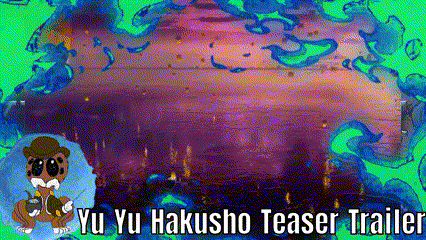
Yu Yu Hakusho Teaser Trailer and Release Date - Why in Any Realm am I So Hyped For This Show
youtube
#YYH #ShonenJump #Anime #manga #LiveAction
#Yu Yu Hakusho#YYH#Hiei#Yuske Urameshi#Kuabara#Kurama#Suiechi#Shonen Jump#Manga#Shonen Jump Monthly#reiki#spirit gun#spirit detective#underworld detective#Botan#kieko#mothers#sons#family#friends#demons#yoakai#yokai#spirits#ghosts#death#life#found family#Youtube
5 notes
·
View notes
Text
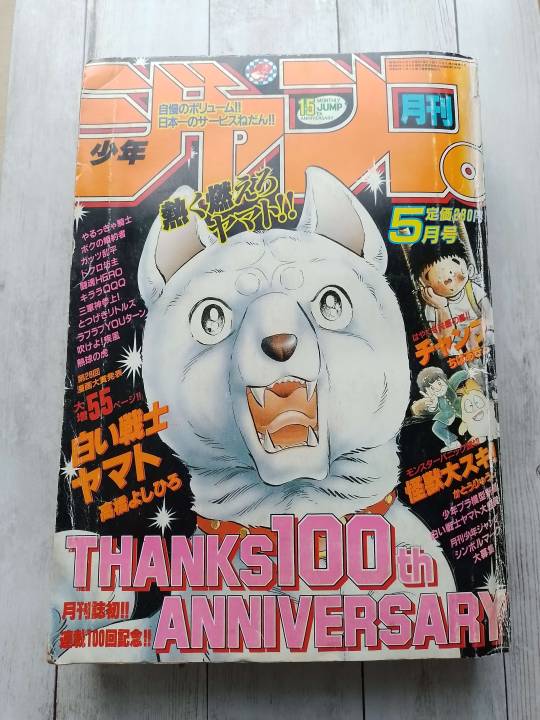

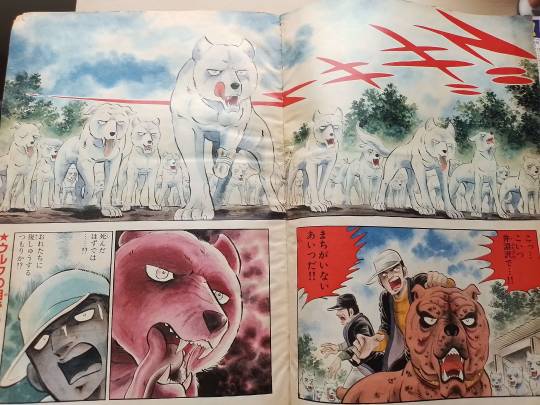
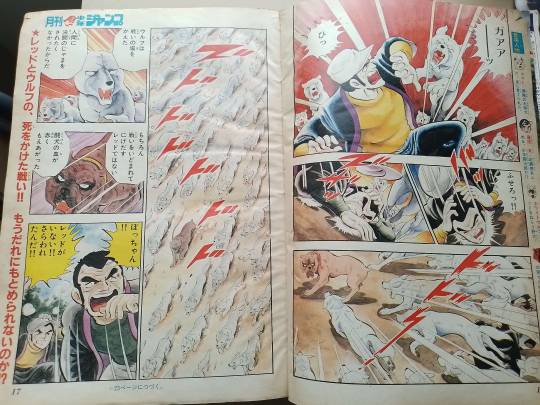
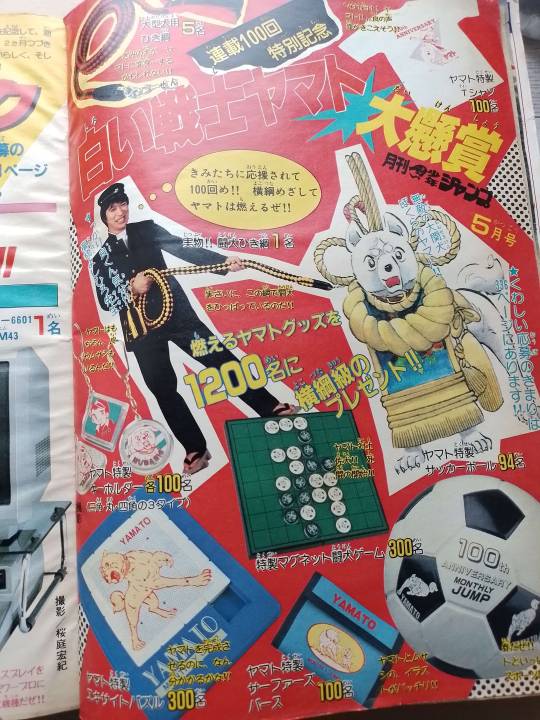
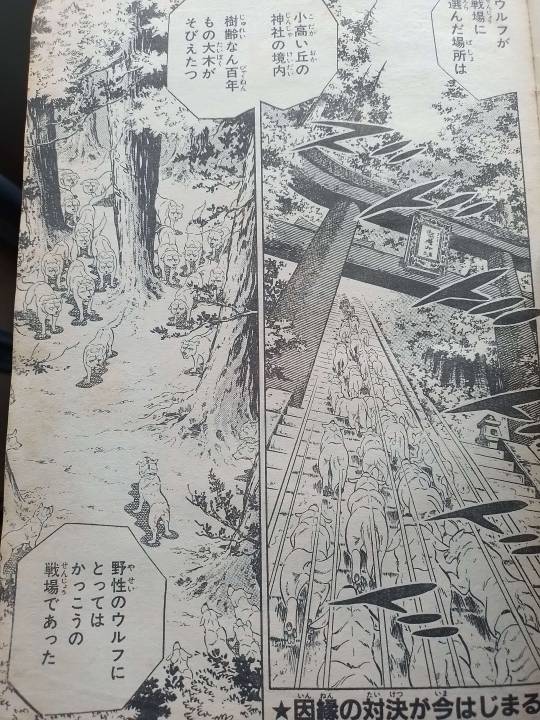

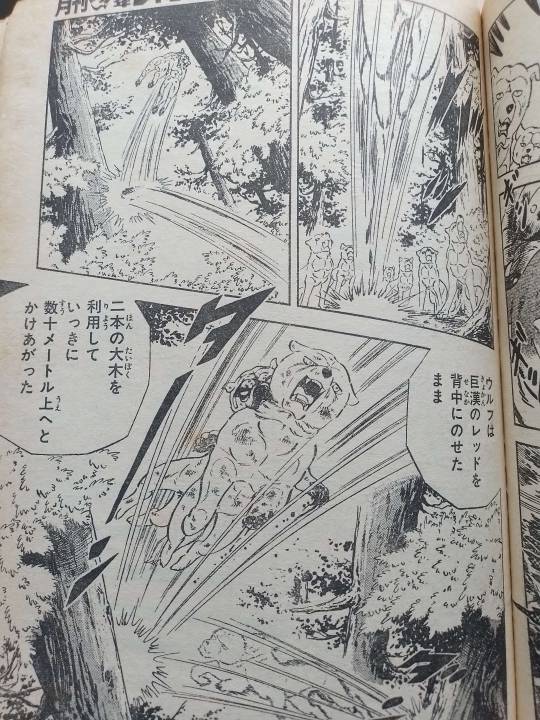
Monthly Shonen Jump [5/1984, #198405]
Magazine that has colored comic pages and merch ad. As well as SSY featured in cover! I am more of a Ginga-series collector but this was such a nice piece of history. I'm a sucker for colored pages and old 80's merchandise that has been lost over the years.
24 notes
·
View notes
Text

23 notes
·
View notes
Text
why am i such a slow reader!!!!
#and a mood reader at that!!!!#i'm dying to know how bnha ends but like....#i have so many chapters left#shonen jump is siphoning all the money out of my measly bank account on a monthly basis too 💀#zee.chats
4 notes
·
View notes
Text

#found my new favourite reaction image#yu yu hakusho#yusuke urameshi#i just started reading it now that its on wsj#i never finished the anime and I only managed to catch the tail end in monthly shonen jump so theres a weird gap in the middle#cant wait to go through the whole thing#i really wanna finish the anime too cause i adore its 90s aesthetic#and yusukes colour fits are absolutely amazing#that green jacket 😍
6 notes
·
View notes
Text
The Weird And Interesting Existence of Japanese Manga Magazines
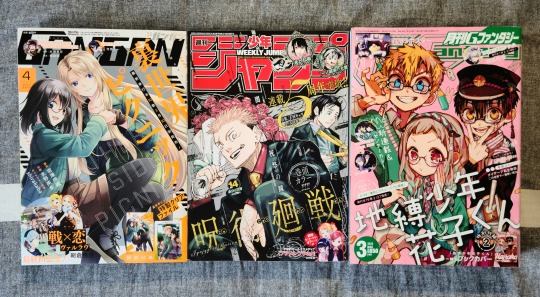
I don't exactly have 30,000 different magazine issues across countless publishers and demographics, but I do have a few (because they have some of my favorite series on the covers), and flipping through them they're all very different to one another, and interesting in their own ways, so I wanted to show just how different, unique, and even at times worth it, these magazines are to NA readers.
⚠️Warning: Minor/Mild Spoilers for Jujutsu Kaisen, Otherside Picnic, and Toilet-Bound Hanako-Kun⚠️
I'm going to break it down by magazine, and I'm going to go left to right from the above image. I'll be talking about bonuses, pricing, quality, content, and a few other observations throughout these three magazines.
Monthly Shounen Gangan
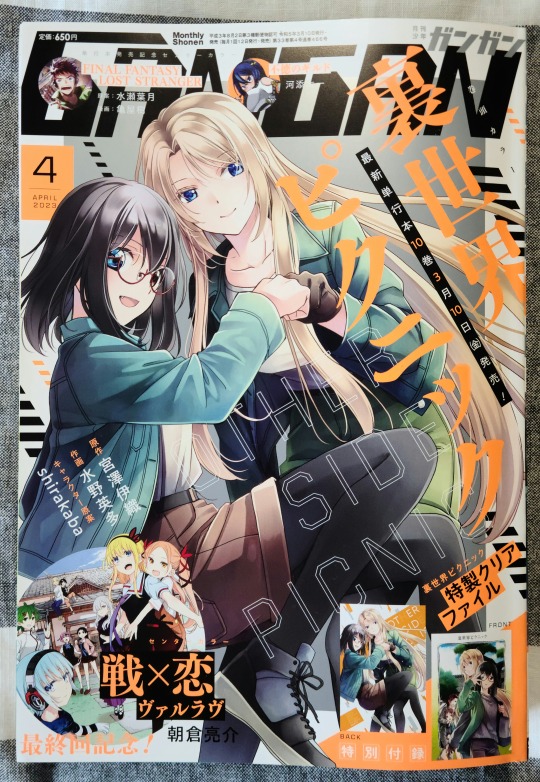
Unsurprisingly, the monthly magazine is better quality than the weekly one. Monthly Shounen Gangan is a monthly shounen manga magazine under Square Enix and carries titles such as: Otherside Picnic (manga adaptation of the LN, and the cover of the issue), Daemons of The Shadow Realm, Final Fantasy: Lost Stanger, and a few others. I wouldn't call it a "packed" magazine per se, but it's definitely got a list of recognizable titles to it.
Anyways, getting into the numbers of this magazine, they're as follows:
Cost -> 650Yen
Number of Chapters -> 21
Number of Bonuses -> 1
Build / Print Quality -> 6/10
Number of Color Pages -> 4
So, only one bonus, but I think it's a pretty solid one, as it's an Otherside Picnic clearfile. Not exactly a super decorative or functional bonus, but I really like the art on it so I'm happy with it.

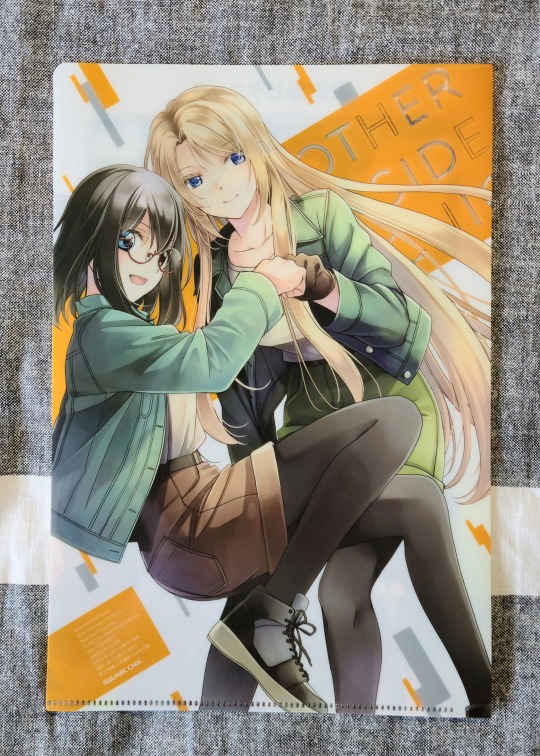
Anyways, into some more detailed information about the magazine issue. The paper itself is very smooth, though it's quite literally paper thin. You won't have any real issues with it, but in lighter or blank areas on the page you can very easily see through to the next page. Similarly, the quality of the ink is pretty hit and miss. Lighter and more gray colors are preserved and displayed quite well, but anything close to or right at black is very spotty and grainy. It even shows in the black used for the panels. I don't think it's something that will really get in the way of reading the issue (if you want to do that), but I also wouldn't say it's all that great.

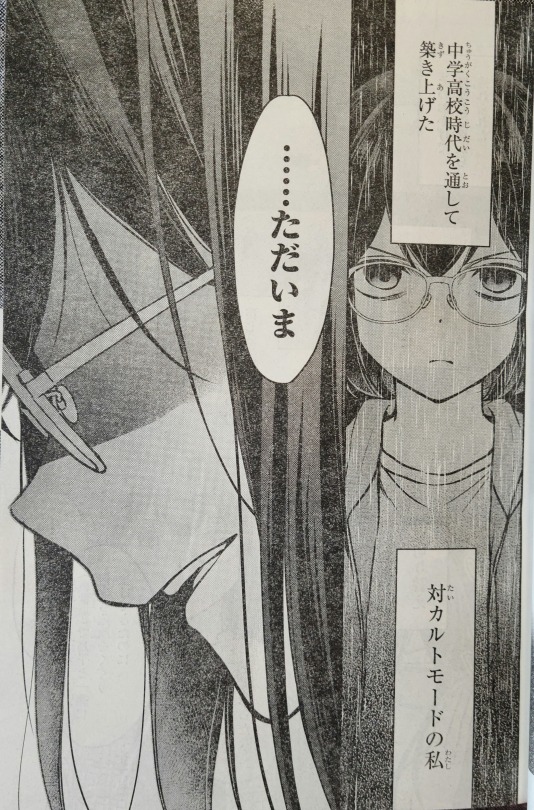
Weekly Shounen Jump

Weekly Shounen Jump from Shueisha is arguably the biggest/most popular magazine for manga. It's got to be accessible, it's got to be quick and it's got to be highly available. Carrying manga monsters like: Jujutsu Kaisen, Sakamoto Days, My Hero Academia, Black Clover, and countless more titles. But does it hold up?
Well, these numbers/thoughts speak to that ability.
Cost -> 290Yen
Number of Chapters -> 19
Number of Bonuses -> 0
Build / Print Quality -> 3.5/10
Number of Color Pages -> 4
So, there you have it. Dirt cheap and highly available magazines require the lowest of standards to get out there. Now, a 3.5/10 might seem a little low, but trust me when I say that this thing is barely readable. The inking is as light as possible to save a Yen or two where they can, and the pages themselves are colored, and they're not even all the same color. It's absolutely something I wouldn't recommend trying to read from period, even if it's less than $3 USD. In reality, for a North American/English reader base, this is a collectable item purely for the covers/color pages.
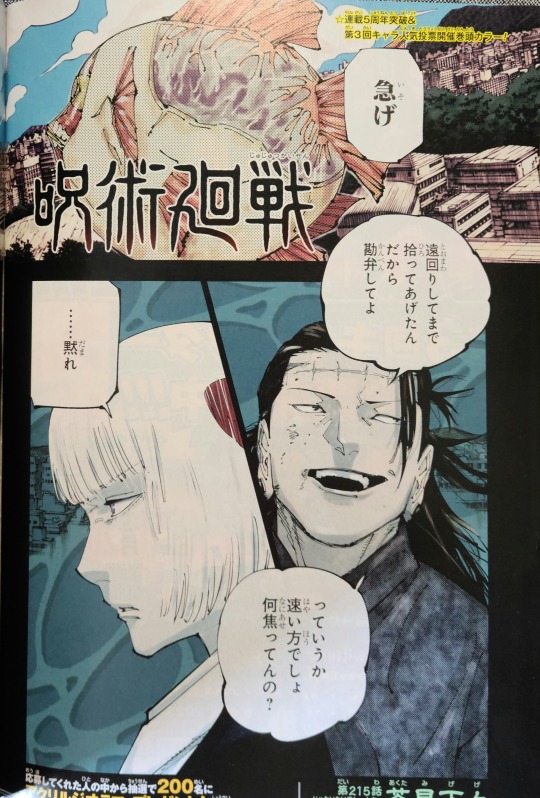
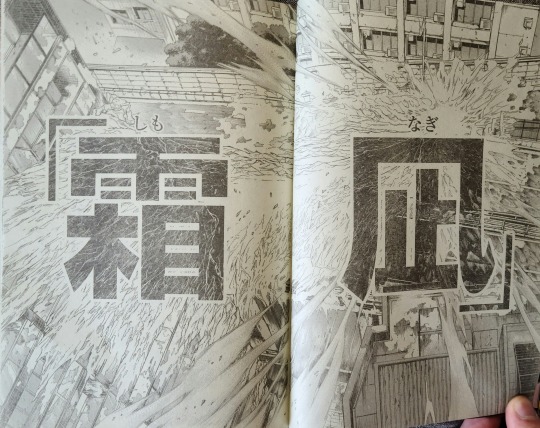
Yeah, I know this page isn't really a great example of the issues with the inking and page colors, but it's one of the few pages from the JJK chapter that isn't a massive spoiler for readers. Instead, take a look at this view of the open end of the magazine.
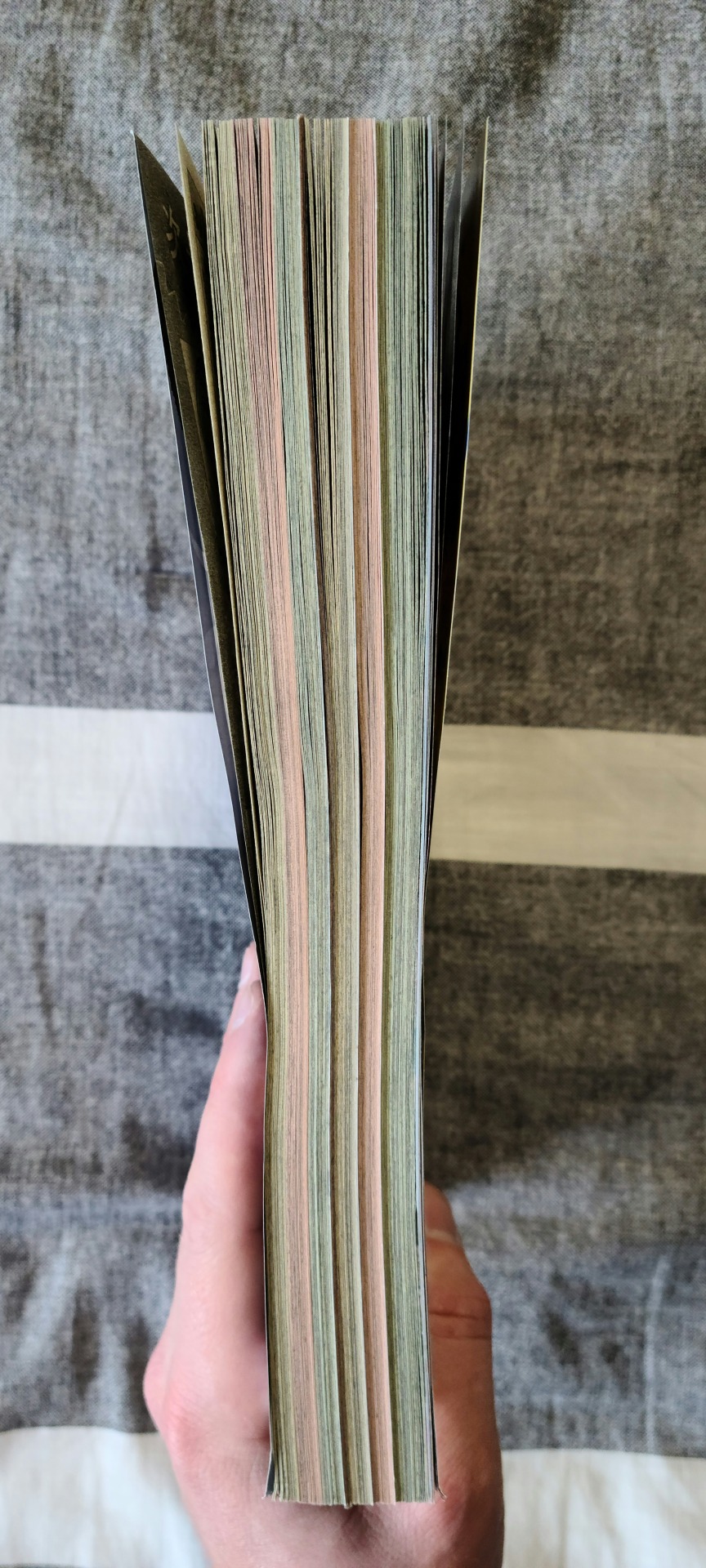
Monthly G-Fantasy
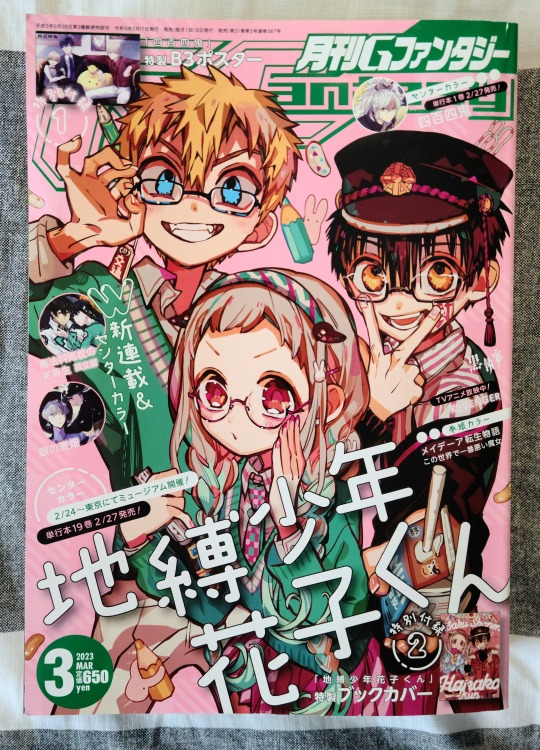
And last, but certainly not least, we've got another magazine from Square Enix: Monthly G-Fantasy. Interestingly enough, this magazine started off as a special issue of Monthly Shounen Gangan all the way back in 1992, but found its way into a fully fledged magazine of its own, sporting popular titles like Hanako-Kun, and well, a lot of titles that I don't really know that much about. Anyways, how does this second helping from Square Enix match up against its progenitor?
Cost -> 650Yen
Number of Chapters -> 22
Number of Bonuses -> 2
Build / Print Quality -> 8.5/10
Number of Color Pages -> 5
A quick interlude to show off the bonuses. You get a (one-sided) poster, and a really cool special edition dust jacket for Hanako-kun (that you have to cut out). Really awesome pieces to add to the issue.
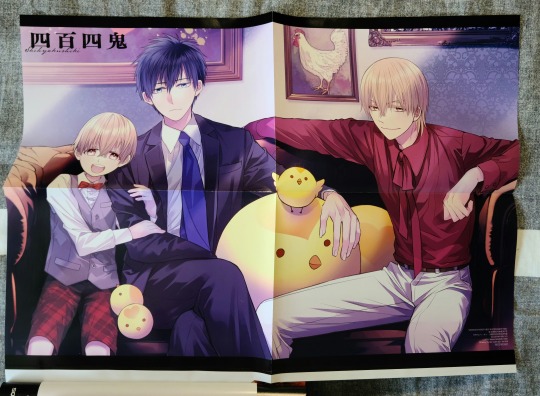
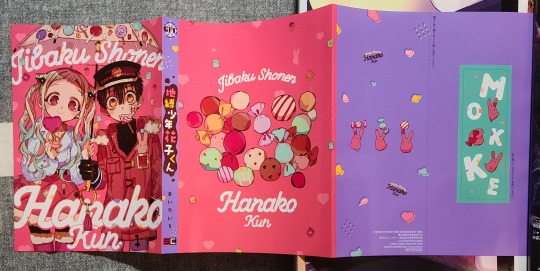
Yeah, I didn't really expect it either. G-Fantasy knocks it out of the park as a magazine, especially at its price point when compared to Shounen Gangan. The paper quality itself is pretty comparable, as both are somewhat thin yet very smooth, but the ink quality for G-Fantasy is just way ahead of Gangan. Really, if it's not better than a lot of Viz manga in terms of ink quality, it's at the very least on par with it. Wholeheartedly, I'd say that it's a better read than most modern regular sized viz manga. Massive trim size with nice paper and lovely ink quality, there's not a whole lot to complain about when you think about it being around half the price of a viz volume for such a large amount of content. So yeah, if you like Hanako-Kun, and potentially some of the other titles in here, and you want to work on your Japanese (and like bonus stuff), there's not really a big reason or limiter in keeping up with G-Fantasy.
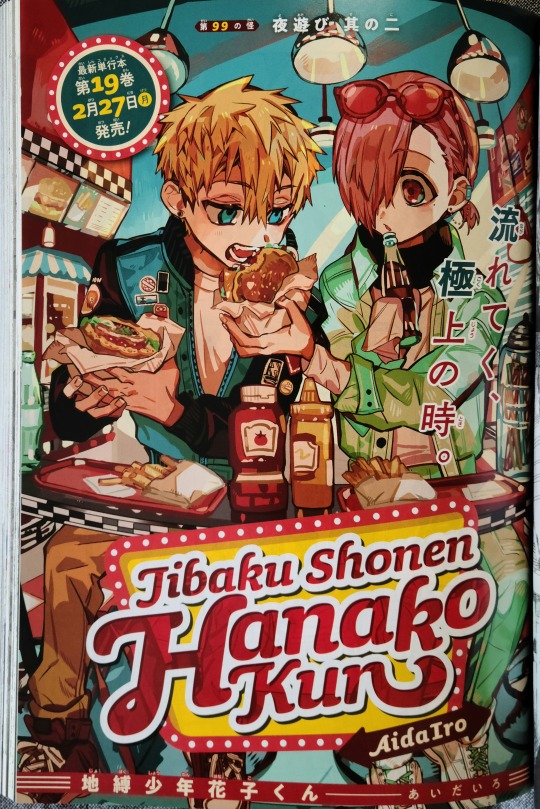

And just a bit of a closing statement/final remark on these magazines. Alongside the chapters, the advertisements and information within were all super interesting. They were sorta all over the place, ranging from ads for pop up shops or merchandise to character information and statements to all sorts of polls and opinion panels. It's a really interesting look into how the culture surrounding manga works in Japan.
So, at the end of the day I definitely think that the monthly magazines are more likely to be worth it for NA readers, but if you're a collector and want to have a cover for your favorite series, I wouldn't really say it's a waste of money at the end of the day.
#jujutsu kaisen#呪術廻戦#toilet bound hanako kun#jibaku shounen hanako kun#jibaku shonen hanako kun#地縛少年花子くん#otherside picnic#urasekai picnic#裏世界ピクニック#manga magazine#weekly shounen jump#weekly shonen jump#monthly shounen gangan#monthly shonen gangan#monthly G-Fantasy#anime and manga#manga
19 notes
·
View notes
Text
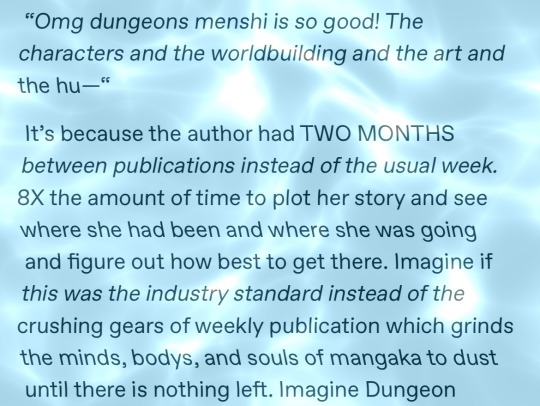
What’s up with how the dunmeshi fandom just lies about this kind of stuff all the time. It is easily confirmable information that it was a monthly series, something incredibly common in the industry.
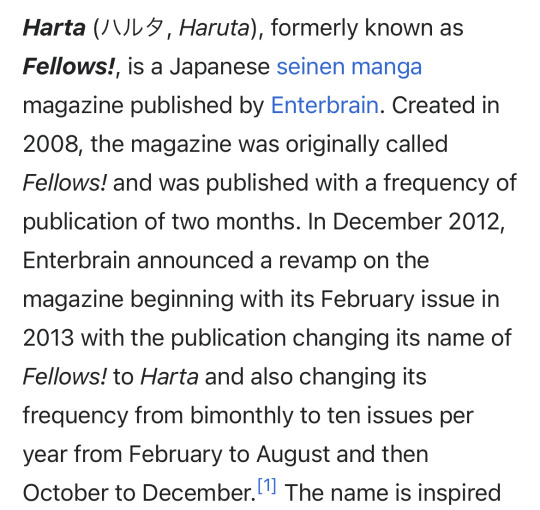
A not weekly magazine schedule is literally common !! Especially in the seinen shoujo and josei demographics, sometimes monthly, sometimes biweekly, sometimes every two months, sometimes seasonal! Please stop lying about how Dunmeshi was some special unique creation that defies all standards of manga just to hype it up because it is so clear that every single one of these comparisons is centered around Weekly Shonen Jump (and understand that SJ has many magazines under its brand that are monthly or semimonthly). Not everything is WSJ and it needs to stop being the only point of reference in conversations like this 🤧
#sorry im having a moment.#kris actually talks#I can elaborate more on this bc I’m a nerd but like#I hope this doesn’t come off as disagreeing with the idea of moving more magazines off weekly schedules#but maybe let’s not lie ??? and act like tons of series including popular ones aren’t already in monthly ones#dungeon meshi#delicious in dungeon#adding the tag also now that it’s going around anyways. hi guys.#sorry for not including alt text originally I was not expecting reblogs but I have added it now o7#blah blah check reblogs with comments for additional thoughts from me if you care etc etc
22K notes
·
View notes
Note
first: dungeon meshi started with two months between updates yes. but then it went to one month. if it stayed on the 2 moth schedule it still wouldnt be finished until 2033
second: plenty of other manga is on the monthly schedule. weekly shonen jump isnt the only manga out there. in fact even shonen jump does some things monthly.
dungeon meshi IS astonishingly good. but pulling everything else in the industry down isnt the way to go about saying that.
Actually i STILL think weekly is fucking awful. Two month is a lot, but monthly is also completely serviceable imo, and if all manga switched to monthly I wouldn't mind in the slightest. We'd get longer chapters more likely and authors wouldn't be as completely fucking stressed.
288 notes
·
View notes
Text
Spy x Family merch updates and manga hiatus
I wanted to post about some recent fandom news, starting with the good news: while I mentioned in my 2-year anniversary post that we've been in a dry spell lately as far as SxF content, we just recently got a bunch of new merch/designs! (mostly from various Jump Festa vendors) I'll start with my favorite of the new designs, from HMV's Jump Festa set - Forgers in winter outfits ❤️

Next is the "French casual" set from Chara-Ani~ Bond's little red beret looks so cute!

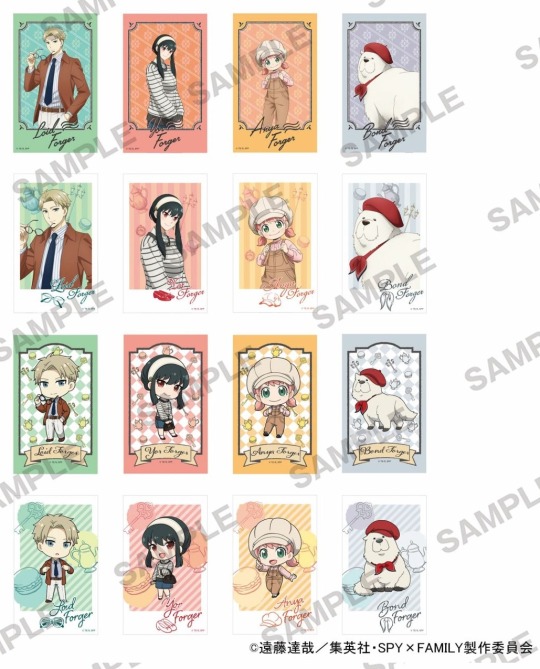
Another winter outfit set, from Animate. Gah, this one's so adorable, too 😭
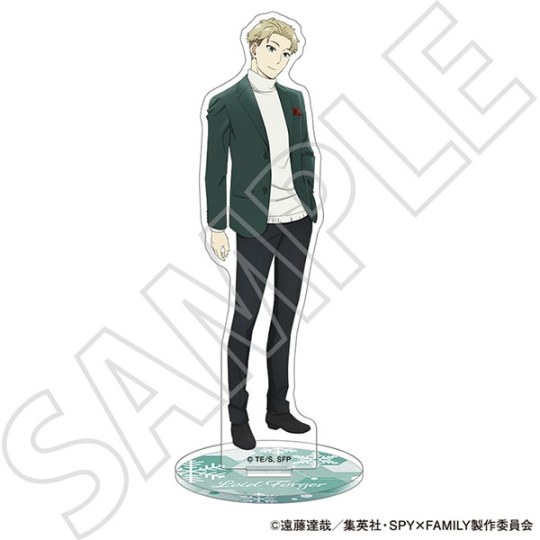


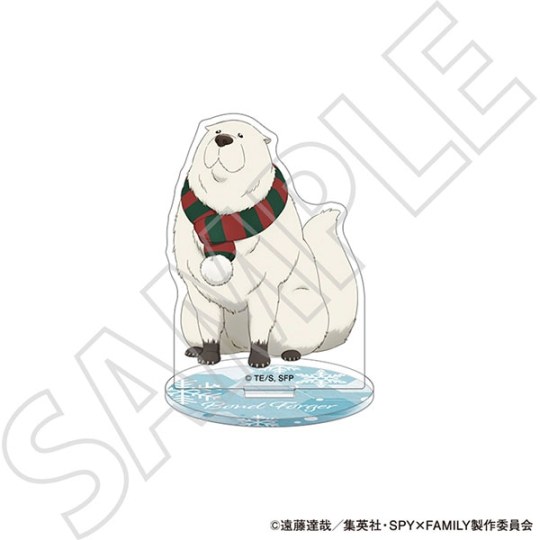

Next is merch from Ichiban Kuji. Not sure if it's for Jump Festa as well, but either way, I want the acrylics and the plate!
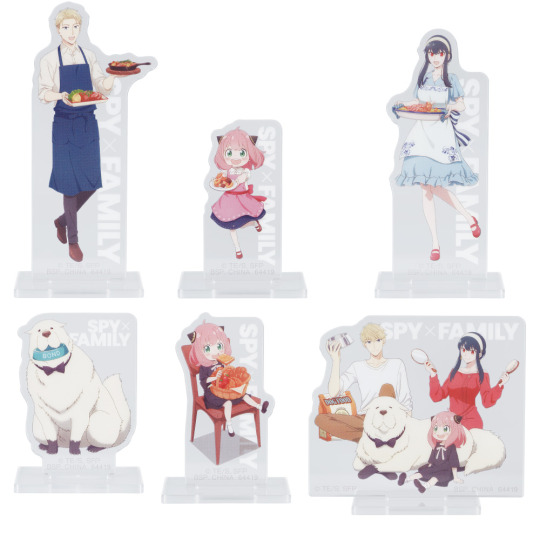
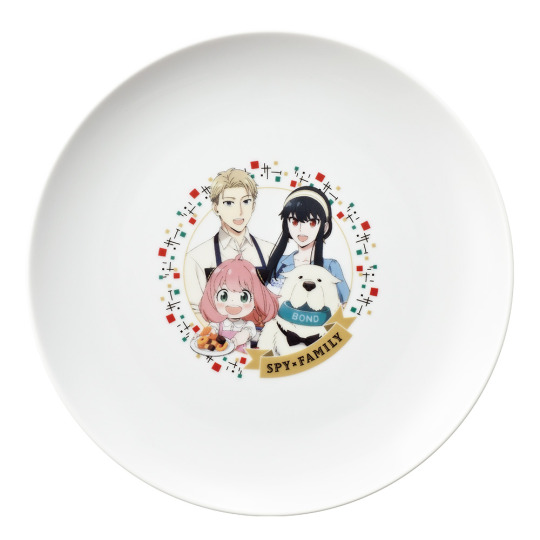
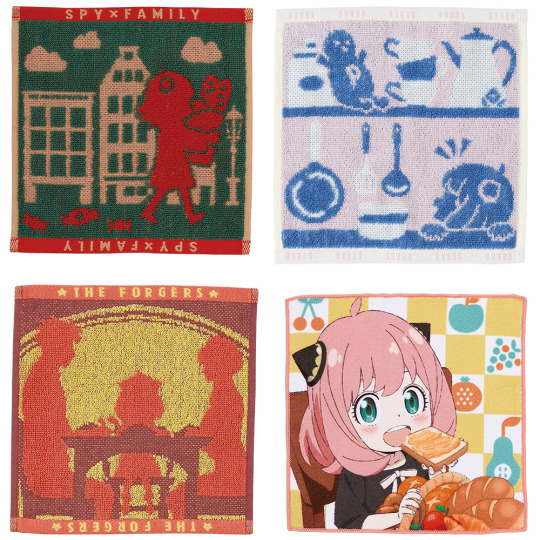
And lastly, Ensky's merch for Jump Festa - Forgers baking cakes/cookies!

Again for those who don't know, Jump Festa is a yearly event held in Japan in late December that's dedicated to Shonen Jump IPs. SxF will have its own panel with the four Forger voice actors in attendance. We've always gotten exclusive announcements and content at past Jump Festas, so fingers crossed it will be the same for this year! I'm gonna try my best to get some of this merch when it goes on sale in late December. And of course, if I'm able to make high quality scans of these new designs, I will post those as well!
Now onto the bad news, which most of you probably heard about already: the hiatus for the SxF manga has been extended to December 23rd. I believe this is the longest hiatus the series has had so far, and what makes this one concerning is not only that the date kept changing, but also the noticeable silence from Endo and other official outlets.
In the Japanese version of the manga, the last page of each new chapter typically notes the date the next chapter will come out. In the case of the most recent chapter, 107, it said it would release on November 25th, meaning Endo would be taking a break from the bi-monthly schedule, which isn't uncommon. But then, just a few days before the 25th, official English manga outlets like MangaPlus updated the release date to December 9th. It was disappointing since we had all been waiting longer than usual for the new chapter, but again, a second postponement wasn't too alarming...what was alarming though, was the third one that came just yesterday, only a few days after the last. People started noticing that official manga outlets had, again, changed the date for the next chapter to December 23rd this time.
The fandom got stirred up quite a bit when this happened, mostly out of concern for Endo's well being. What made me particularly worried was the fact that, while these hiatuses had been going on for the past month, Endo hadn't posted anything on his Twitter account, which is very unusual considering every month prior he's posted at least a few unique illustrations. Not only that, but the last thing he posted was this oddly cryptic image on October 19th, with text that says "Don't look for me." And he then deleted it soon after, which makes it even stranger.

But thankfully, Shonen Jump must have noticed the pandemonium happening in the fandom, because just a couple hours later, they made this statement on the official Jump+ Twitter, apologizing for the delay and confirming that chapter 108 will indeed come out on December 23rd.

This to me was good news, since their official statement about it makes it unlikely they'll change the date yet again. But some sort of explanation would have been nice, even a vague one. I'm not someone to spread rumors, but my own personal speculation (which could be totally wrong) is that there was some dispute between Endo and Jump. This is the only explanation I can think of as to why his Twitter would suddenly be barren for a month after he posted consistently for so long - my guess is that he has to get approval from Jump for all the illustrations he posts there. I don't know much about the inner workings of the manga industry, but I would assume he has some contractual obligations where he can't freely post stuff on social media without some sort of publisher's approval. It is possible he's just been too busy with Jump Festa and other things, but he's still posted at least a couple times a month even when he's sick or busy, so I don't think that's the main reason. Again, this is just my speculation that could be completely wrong. There's also the fact that they so quickly changed the release date to the 23rd, the day right after Jump Festa ends, which could indicate that Endo's been busy cooking something big to be announced there. Regardless, I'm happy we finally have a new chapter release date that's pretty set in stone now, though I won't feel totally better until we get clear acknowledgment that Endo is okay, either from himself on his own Twitter or somewhere else official.
Anyway, despite this setback, I'm relieved that SxF is still going strong with all the hype for Jump Festa and season 3. Between that and the new chapter right after, we'll be eating good this Christmas!
#spy x family#sxf#spy family#spyxfamily#sxf manga#sxf anime#sxf merch#loid forger#yor forger#anya forger#bond forger
123 notes
·
View notes
Text
The Curious Case of Kaitou Kid
(UPDATED 11/27 JST. Sections with significant new portions will be bracketed with a ☘️)
We love alliteration in this household.
To start with an anecdote, I went to the main Animate store in Ikebukuro some 2-3 weeks after M27 began showing in theaters. I had two reasons to be there: hopefully grab some copies of the Magic Kaito Treasured Editions, and grab what movie-related merch I could. The former I managed, but the latter was a lot harder. Despite them devoting nearly an entire wall on the right side of the first floor to Detective Conan merch, every single piece of non-blind box Kaitou Kid merch had been snatched up already. This trend of Kid’s merch being sold out seemed to continue for at least a couple weeks afterward, at least in and around Tokyo.
This demonstrates something I think we all already know: Kaitou Kid is a crazy popular Detective Conan character.
…Detective Conan character? Yes, but… No. But definitely yes. But… yes?
Kaitou Kid - real name Kaito Kuroba - is such a funny character if you think about him for more than a few seconds. So I chose to think about him for a few, uh. Days.
When I say he’s funny to think about, I don’t necessarily mean in terms of who he is as a character - which is admittedly also fun, because I think Gosho Aoyama is the king of gap moe - but more in terms of his placement in the greater DCMK canon. I mean, the fact that we have the “DCMK” acronym at all signifies the importance of tying these two series together. Even though they technically take place in different worlds. You know. Technically.
So I want to (mostly) chronologically go through Kid’s history in Detective Conan, how it relates to his origin as Kaito Kuroba in Magic Kaito, and amuse myself with the strange relationship he (and his source manga) has with the juggernaut that is Detective Conan.
Before we jump into this, some basic notes:
-I don’t mean for this to come across like some academic thesis. Nor did I actually think this would hit over 18k words. I’m just Like This.
-Any translations you see here are done by me, from the source Japanese.
-There will be concrete mentions of events from M27. They are comparatively trivial in terms of the mystery the film offers, but there will be spoilers for certain major parts of the plot as they relate to Magic Kaito elements. This will be clearly demarcated, should you wish to avoid those spoilers.
The MK to DC Pipeline
So I don’t know how many people actually need this information, but for completion’s sake:
Magic Kaito is Gosho Aoyama’s debut serialization (important distinction), and it began in June 1987. Though roughly the first two volumes’ worth of chapters were published at a fairly consistent monthly rate, it grew more and more irregular after that due to the popularity of both Yaiba and (more importantly for our discussion) Detective Conan. Due to it still technically being an ongoing series, it is currently Weekly Shonen Sunday’s longest running manga. This just so happens to be followed by Detective Conan, and they lead this particular ranking by a fairly wide margin.
The manga as it currently exists came out of the one-shot “Nonchalant Lupin,” which he submitted to Shonen Magazine’s manga contest after his editor told him to “draw the story you most want to draw” (Treasured Ed. V5). The one-shot won an honorable mention. His comment in Treasured Ed V1 also mentions that he “all but became a mangaka because I wanted to write about a high school kaitou,” so he’s clearly attached to the concept. He’s also clearly attached to Magic Kaito itself; a number of excerpts from the Gosho Aoyama 30th Anniversary Book, for example, talk about how a greedy part of him immediately thought of Kaitou Kid on the silver screen when he heard about the first movie being greenlit, or how he thinks Detective Conan will one day end but Magic Kaito may not because that’s what he really wants to be writing.
Back to our timeline: the Kindaichi Case Files were gaining steam in the early 1990s, and Weekly Shonen Sunday wanted its own version of the boom. Gosho himself was approached by the editorial team at Sunday to do a mystery series, and he accepted, not thinking it would last very long - not only because he wasn’t all that interested in the idea, but because he didn’t think there would be enough material to last more than three months.
It has lasted 30 years.
I say all this not to indulge in the depressing truth that Magic Kaito only has just shy of 40 chapters, but to specifically highlight the synergy Magic Kaito has with Detective Conan - despite the existence of magic in the former - due to their shared inspiration of Arsene Lupin. Things like Sherlock Holmes and Kogoro Akechi are pretty obvious inspirations for Detective Conan that I don’t need to go into in much depth, but the idea of a “high school kaitou” still very much bleeds into aspects of Conan’s character. Many of the things Kaito is either capable of naturally or has to deal with due to the inherent nature of his position are things that are also reflected in Shinichi.
Feats of physicality (Comes naturally to Kaito due to genetics and practice; enhanced for Conan via Agasa’s inventions)
Master of disguise (A practiced skill with makeup and voice changing for Kaito; use of a voice changer and aid from people in his life to deal with disguises)
Secret identity (a flipped perspective version: Kaito has a straightforward secret identity, while Shinichi has to keep his survival a secret)
The “bumbling police” (A good kaitou story will have a morally upstanding but kinda dumb detective that demonstrates the sheer skill of the kaitou in question while putting a contrast to their morals. Nakamori is this to Kaito; though not a one-to-one, characters like Megure or Kogoro serve similar roles to Shinichi to demonstrate his skills as a detective.)
“Why are you like this????” (Admittedly the most Vibes of the list, but there’s a level of gray morality. We root for the main character while knowing that what they’re doing is at times questionable. Kaito goes without saying, but Shinichi is more likely to engage in suspicious behavior like breaking into cars, bugging people’s houses, or even stealing evidence after becoming Conan.)
Motive (The most interesting - and sometimes the funniest - overlap is the fact that they’re both after a shifty organization. It’s a bit surface level at first, but there’s a suspicious level of overlap between not Shinichi and Kaito, but Shinichi and Toichi.)
All of this is to say that pushing DC and MK into DCMK is almost comically easy once you adjust for tone (and, uh. remove Akako, I guess) because Shinichi is BUILT from the kaitou framework and tweaked into a detective. So it’s no wonder Gosho decided to throw in a Kaitou Kid cameo that turned into the character asserting himself as a recurring sub character, as opposed to a quirky crossover character.
Even if he’s still both. And also a secret third thing.
The Last Wizard of the Black Star

So, there’s not much to mention about Magic Kaito’s early run. All chapters in the pre-DC era are stand-alone stories, with the plot starting and concluding within the span of a single chapter. It was a bit of an “anything goes” era, with the genre fluctuating all over the place and a lot of things we consider “standard” in any given Kaitou Kid story not yet being fully codified. Many of these weirder chapters have their own charm if you allow the gag manga energy to take you for a ride, but if gag manga isn’t your thing then it feels like these chapters are where Kaito himself is at his most…incongruous with the character that would eventually show up in Detective Conan. (Let it be known for the record that I personally find these early chapters SO silly and would kill for an animated adaptation of Clockwork Heart, the truly bonkers third chapter.)
The biggest “what do you MEAN that wasn’t there from the start?!” is by far Blue Birthday, which is the chapter of Magic Kaito that was published immediately before Detective Conan began serialization. It took about half of the currently released chapters to introduce Pandora, a now fundamental concept that is likely to be included in ANY one-paragraph summary of Magic Kaito’s plot. It isn’t the only thing, of course; though Kaito’s card gun debuts in the very first chapter, his hang glider doesn’t show up until Chapter 10.
The other major thing worth pointing out in the pre-Black Star era is the general pacing and fundamental makeup of the stories themselves. Very few case-only (or heist-only, as it were) characters show up in these chapters. When they do show up, they tend to be pretty flat, are often ridiculous, and are there to facilitate the hijinks of the day (the gun-crazy detective, the weird robot inventor, the irresponsible prime minister).
This changes with Green Dream, and it’s an immediate change. Detective Conan has been in serialization for over half a year by this point, and already its formula is bleeding into Magic Kaito. There are multiple new characters per heist, and multiple pages with two to three times more text than before are dedicated to setting up a fundamental conflict. Kaito is also more likely to take a stance in this fundamental conflict and use his talents and status as Kaitou Kid to lead it to a conclusion. Behind all of that, though, Kaito himself is still the cheeky little agent of chaos we all know and love throughout these chapters. (As an aside, the Kid mark used on his advanced notices debuted in this chapter!)
The big watershed moment is very obviously Black Star - the Detective Conan version, in this case. In both this and the Magic Lovers case (despite his very little screen time in the latter), readers of Detective Conan are introduced to a FAR more serious version of the Magic Kaito character. This is largely because what we’re seeing in Black Star specifically is a 100% outsider's perspective. Though we’ll very shortly find out this is not Shinichi’s first meeting with Kid chronologically, it is the first time he not only hears his name, but also has any real interactions with him. Kaito wears the mask of his father in his performance as Kid, and you could very much argue his guard is WAY up around probably the weirdest child he’s ever met. So in a story from Conan’s perspective, we have no way of seeing behind that mask.
Personally, I always put a bit of an asterisk next to DC’s Black Star. This is the case that feels the most like a “crossover” than any other Kid case after this, and of course it would. It’s the very first one! It’s the Kaito and Aoko cameos that really bring this vibe for me personally; great care is taken in Detective Conan not to pull much of anything from Kaito Kuroba’s personal life except in a few stand-out cases, and those almost never involve anyone in our core cast directly. And I don’t even mean in the “he’s only ever shown in his Kid costume” way, because there are plenty of times where he shows up not wearing that. They key for me is that Kaito is always “at work” as a disguised Kaitou Kid as opposed to as Kaito Kuroba - the hat, the darker clothes, the low-effort disguises as police or staff. That kinda thing. But the appearance of Kaito and Aoko in their casual wear or school uniforms here really makes this case stand out in a way that later cases simply don’t joke about.
Detective Conan shows us Kaito at work. It’s why he comes across as so difficult to grasp and almost intimidating in these earliest of appearances. Those vibes obviously continue into The Last Wizard of the Century, the third theatrical release and Kaitou Kid’s very first movie appearance! His grand total screen time is only a fraction of the movie’s full run, but the vibes have a heavy overlap with that first conversation Conan has with Kid on the roof in Black Star. Though there are debates regarding the movie’s canonicity, this also marks the point in at LEAST movie continuity where Kaito figures out Conan’s identity, so there’s that precedent set. (Put a pin in that, by the way.) This also marks the first time Kid disguises himself as Shinichi.
What’s more amusing to me is that Magic Kaito’s Black Star seems to have been published to coincide with the movie’s release. Magic Kaito’s very first chapter after Kaitou Kid’s appearance in Detective Conan brings Shinichi Kudo to Magic Kaito. This is his only appearance in Magic Kaito to date, whether it be as Shinichi or as Conan. Gosho mentioned in his note on the Yaiba vs Kaito chapter that he really likes crossovers (same hat), so I have to think that the limited run of Magic Kaito is likely why we don’t see more DC characters in MK. Though in a Q&A he did toy with the idea of Conan showing up in Magic Kaito one day, so…
All that said, every time I think of MK’s Black Star my brain shoots off in two directions. The first and easier to articulate direction involves Akako’s presence, but we will get to that in the next section. The second direction is the very existence of this chapter at all.
As I mentioned above, this is the first new heist for MK after Kid showed up in DC. It is also the first multi-chapter heist, which indicates even more influence is bleeding over. It was also published alongside the movie, probably as part of a promotional stunt. Something about it feels like a doubling down of sorts on the stapling of these two series together. Kid showing up in Detective Conan is a fun reference; Shinichi showing up in Magic Kaito instead of the more recognizable Conan feels like a statement of shared worlds, largely because of how it makes you think about the timeline. The Akako issue aside, it really feels like he wanted these worlds to collide. If you have your own Lupin analogue AND your own Sherlock analogue, why wouldn’t you want to pit them against each other?
Add More Staples!

It’s at this point that updates to Magic Kaito get… particularly sparse. But there’s a LOT of stuff going on across the DCMK space as a whole in these few years that feels like it’s trying to tie the two series together.
We start off with the Twilight Mansion case, which introduces Hakuba into Detective Conan. Which would be fascinating by itself, but this was also Hakuba’s first appearance in EITHER DC or MK in TEN YEARS if you don’t count his one-panel cameo in MK’s Black Star. The framing of his introduction in Detective Conan is interesting, because the paneling and composition very clearly tell the reader that the character that’s about to be introduced is either 1) important, or 2) already known. In Hakuba’s case it’s clearly the latter, but this would make very little sense to someone that isn’t as aware of his place in Magic Kaito.
Enter The Gathering of the Great Detectives, the animated adaptation of the Twilight Mansion case that was turned into a two hour special and opened with MK’s Black Star. There are ways in which it’s an odd choice, given Hakuba barely appears in Black Star at all. But I think Hakuba’s status as yet another Magic Kaito character being introduced into the narrative provided an opportunity for them to adapt a Magic Kaito heist for TV broadcast, and the chapters featuring Shinichi were the easy choice. The Yaiba vs Kaitou Kid vs Conan OVA had come out shortly before this, so it’s technically not the first time a Magic Kaito chapter had been adapted. But that was more of an altered gaiden OVA compared to this, and this TV adaptation seemed to hit you over the head even harder that there was merit to delving into Magic Kaito if you were a fan of Detective Conan.
☘️Between these two was the first of many OVAs, and the first of a couple of attempts to shove Conan into Magic Kaito material: Conan vs Kid vs Yaiba. This is an adaptation of an August 1993 chapter of Magic Kaito, and is the chapter that broke a roughly three year break in publication (it was then followed a few months later by Blue Birthday). Much of the main plot of the chapter is largely kept intact, with one fairly major (and obvious) difference: Detective Conan’s involvement. Much of the core DC cast has been dragged into the plot, which is at first a little odd considering the explicitly battle shounen-style magical flavor of Yaiba.
This OVA handles that incongruity with the “fever dream” solution. In Conan’s side of the story, things get increasingly more and more ridiculous until the final reveal that Conan had fallen asleep reading Yaiba. Which is to say that, plot wise, the OVA ultimately amounts to nothing. But that’s fine, because what’s more interesting is how early they display Kaito’s carousel of emotions in this OVA as compared to the “mainline” media (manga or movies). What’s also worth noting is that this is the first appearance of Akako in DC media, right before she gets a more mainline debut in EP219. She’s a one-scene wonder, bursting in with an ominous fortune and leaving in a very magical disappearing act.☘️
But the OVA, in the aforementioned fever dream context, excuses her existence. In the manga, though? Oh, Akako. Bane of the DCMK world. Sole reason we must argue that they take place in parallel worlds despite how ridiculous that sounds.
In the manga, Akako gives Kaito her premonition about the Demon of Light coming after the White Sinner. This is also in the episode, if memory serves. But in the episode as aired on TV, Akako features very little after that… because they fully cut the scene of her attempting to use magic at the base of the clock tower. Magic does not exist in Detective Conan, after all. It was eventually put into the episode another ten years later on the bonus DVD that came with certain versions of the Treasured Edition of Magic Kaito Volume 4.
More broadly, Akako is clearly a sticking point for the combining of these two “worlds” into one. Gosho himself takes the easy way out by ignoring Akako’s existence entirely in the Detective Conan canon, just as the TMS adaptation of Black Star did. He’s often brought up the concept of the two taking place in parallel worlds where the only major difference is the presence of magic in one and its lack in the other, as in his comment on Akako’s intro in Treasured Ed. V1: “In truth, the biggest bottleneck when it came to introducing Kaitou Kid into Detective Conan was the inheritor of Red Magic herself! So please just accept the two series as parallel worlds (lol).” He’s much more straightforward in his comment for Sun Halo in Volume 5: “You really gotta have Akako use Red Magic! (Please just assume Akako does not exist in the Conan world…lol)”
Despite this insistence she doesn’t exist, Sky Walk features an almost blink and you’ll miss it reference to her. Nakamori brings up the idea of Kid’s assistant being in play, to which Conan shows surprise at him having an assistant at all. Nakamori replies that there are multiple reports, some of an “old man” and others mentioning a “young woman.” The old man is obviously Jii, but the young woman is very likely meant to be a reference to the stunt Akako pulls in Akako’s Delivery Service, a very early Magic Kaito chapter.
As you’ll notice, Akako is still very much a practitioner of sorcery as of something as recent as Sun Halo, so it’s not as though Gosho has simply opted to phase her or her magic out of Magic Kaito. But considering there are MULTIPLE DC cases that deal with debunking the supernatural, her presence would most certainly complicate things. That being said, Magic Kaito’s world and plot do not seem to hinge on magic in an intrinsic manner (unless Pandora is literally a magic gem, as opposed to the tale of the gem being a metaphor for something), so I personally don’t see too much of an issue with magic being very rare, even in Detective Conan’s setting.
To keep with Magic Kaito for a little while longer, Golden Eye was the single heist released during this period. As far as its significance is concerned, I actually think Gosho said it best in his comment in the Treasured Edition: “Magic Kaito may be a thief story, but it’s also a magic story, so it was incredible to finally be able to mention the actual legend Harry Houdini. Even so, there’s an awful lot of deduction going on, so in this story you can also really feel how it’s been corrupted by Conan (lol).” It was a thought I had about Golden Eye even before reading his comment, so I’m a bit amused to find he actually called it out to be honest.
The following Detective Conan cases - Sky Walk, Three Instruments, and Four Masterpieces - and the movie Magician of the Silver Sky are all more along the lines of Black Star in terms of Conan and Kid’s relationship, but with an extra added pinch of “coming together for a common cause” in the movie. Sky Walk specifically also introduced Jirokichi to the mix, and he becomes the only Detective Conan character whose purpose in the narrative is tied exclusively to Kid. It’s in this way we begin to create a Detective Conan-exclusive environment for Kaitou Kid, which in turn establishes him more and more as simply “a Detective Conan recurring character” as opposed to the main character of another story that’s here for crossover shenanigans.
There’s a Pandora’s Box reference in Three Instruments that makes me want to pull my hair out because don’t say Pandora that word is important, and Four Masterpieces is a lot more “murder mystery involving Kid.” They happen very rarely in Detective Conan, but they happen basically NEVER in Magic Kaito (Dark Knight doesn’t count), so this lowkey feels like another way we’re shoving Kaitou Kid into the rules of Detective Conan.
In Magician of the Silver Sky, Conan expresses a level of shock when “Shinichi” passes the pinch test. This then marks the first time (in movie continuity, at least) that Conan is aware that Kid naturally resembles him.
But the funniest thing about this series of cases (and the movie) for me is the cracks in Kid’s mask, whether that be for Conan himself or for the reader. The final confrontation in Sky Walk ends on an almost comical note with Kaito being blasted off again via gasoline fire, and there’s a stinger at the end of Four Masterpieces showing a pathetic Kaito after Conan has just shot a mecha-powered soccer ball directly at his stomach. And that’s not even getting into the movie, whose entire first act drops us into a tense confrontation with a very suave Kaitou Kid before rewinding back to when he put on the least convincing act ever as a disguised Shinichi Kudo.
Have I mentioned he contains multitudes yet? King of gap moe.
But we aren’t truly there yet. He’s a little silly for sure, but there are still times where the mask is on about as tight as it can be in Conan’s presence.
☘️The last two OVAs from this era - Conan, Kid, and the Crystal Mother and Follow the Vanished Diamond - have varying levels of significance. The latter matters extremely little to this conversation on the whole except for Kid finally showing up toward the end. Heiji and Kid have only ever had cursory interaction in DC to this point, and this frankly continues that trend. It’s worth noting that its release right before Movie 10 is significant specifically in this regard, though.
No, what’s way more interesting is the extremely forced adaptation of Crystal Mother. The bare bones and much of the meat remains - it’s still very much recognizably Crystal Mother in every way that matters and then some - but we’ve once again stapled Detective Conan to an adaptation of a Magic Kaito chapter. To accomplish this, they find ways to make Magic Kaito fit the world view of Detective Conan, like with OVA 1… But this time, it requires many more changes that wind up feeling a little more forced.
These changes are largely focused on Pandora and MK’s organization. Though Kid still looks at the jewel through the moonlight, all mentions of Pandora are dropped. Snake being recognized by Conan under the code name “Jackal” as an international jewel thief also has some interesting implications. A more generous reading would be that he potentially had another, more general-use, code name before joining his organization and receiving the name Snake; a less generous reading would be that the OVA has recycled Snake into an otherwise original character for the OVA that has taken Snake’s place, thereby removing any implications of a Pandora plot existing at all. Regardless, Jackal seems to have had previous run-ins with Kid. Which of these readings you opt for greatly changes the implications of Kid’s own personal plot in DC. At this point, despite pulling a very real crossover this time around, they apparently aren’t ready to commit to Kid’s motives being the same across both series.
In addition to Jackal, an assassin by the name of Rose is introduced in this OVA. Though she’s working with Jackal, her purpose seems to be to give Conan someone to confront in a more tangible manner, since Conan and Kid’s paths can’t really cross without drastically changing the story. Otherwise, the last major note I have for this OVA is the final scene. Conan hearing Kid saying he’d come after the Jewel of Destiny next is a nod to the at-the-time upcoming movie, Movie 8.☘️
The last two stories mentioned here - Detective Koshien and the movie The Private Eyes’ Requiem - are actually a lot less about Kid and a lot more about Hakuba. So let’s talk about the cosplay detective for a little while.
Hakuba is interesting to me, for a couple different reasons. One is the cadence of his appearances in Magic Kaito. He is introduced late into the pre-Blue Birthday run and is in a total of three chapters. Those three chapters speedrun his discovery of Kid’s identity… and then he’s gone until his first Detective Conan appearance. Golden Eye is his return to Magic Kaito in a short but fairly significant scene that fills out the contours of his relationship with Kaito with regards to that identity, at which point he is in all but one case thereafter.
The other reason is that he seems to slip through the cracks of “significant Kaitou Kid relationships” unless you consider yourself a Magic Kaito fan. But I think this is largely due to the line in the sand we shall not cross: Kaito Kuroba’s personal life is off-limits in Detective Conan. As a result, Hakuba is framed far more often as a detective in his own right that just so happens to have some manner of connection to Kaitou Kid in his few Detective Conan appearances.
This connection is made fairly obvious in Twilight Mansion by both having him introduce Kid’s presence in the case, and having him and Conan highlighted as the two people that are after him at the end of that case. But his next appearance, Detective Koshien, only implies a connection in passing and chooses instead to focus on contrasting him with Heiji in preparation for the movie. In an interesting move, the plot developments of the case actually give Hakuba an excuse to avoid wearing a school uniform like the other students because he ultimately settles into the “foreign detective guest” role. There are, as a result, zero indications that he and Kaitou Kid’s civilian identity are actually classmates - or that he attends a Japanese school at all.
As for the movie itself, Hakuba was Kid in disguise the entire time, so there’s very little we can discuss when it comes to Hakuba himself. But after Kid’s frankly poor performance as Shinichi in M8, his performance as Hakuba in M10 is almost uncanny levels of spot-on (which admittedly turns into a very funny contrast with his Hakuba disguise in Green Dragon).
All in all, this selection of chapters, episodes, and movies pulled more of Magic Kaito into Detective Conan (when those details weren’t flying in the face of it), while Kid himself began to more closely resemble the Kid of Magic Kaito in the small moments. In Magic Kaito, meanwhile, we’re starting to see far more obvious influence from Detective Conan in the writing and pacing of its heists.
But the gates have not yet been thrown wide to truly allow the silly in.
Throw Wide The Gates That We May Sillie

The collection of chapters that start this portion of the list are, in a word, fascinating from a Magic Kaito perspective.
We start with Shinichi’s Childhood Adventure, which does a couple of notable things. First, it confirms that Toichi was the magician that taught Yukiko how to use disguise makeup for her acting career. It was implied to be him in a very “if you know, you know” fashion in the Golden Apple case over 200 chapters prior, but this makes it inarguably clear. The extension of this confirmation is that Toichi also taught Vermouth the art of disguise, which is a particularly interesting connection to think about. As obvious as it sounds to say, this chapter is also the start of confirming that many things we know of Magic Kaito’s plot and backstory remain consistent in Detective Conan as well. The case ensures you don’t need prior Magic Kaito knowledge to pick up on Toichi being the first Kaitou Kid. That he meets Yukiko with Kaito in tow also means (unless my memory is failing me) that this is the first and only time Kaito’s name is spoken within the Detective Conan manga. It also confirms that the author that named Kid was, in fact, Yusaku.
The big part of this case that people tend to bring up in the wake of the M27 reveal is the “I’m your younger brother” conversation from Toichi to a young Shinichi. Now, 2006 is earlier than what meager sources I’ve managed to find that seem to indicate he had the familial relationship in the back of his mind, so I’m personally not sure how much stock I place in this conversation as any form of foreshadowing. The other aspect people bring up with regards to the family terminology - the reversial of younger and older brother - is easily answered by the context the case is set in. Toichi is referring to the order in which Yusaku named them - Shinichi first, as Yusaku is his parent (親, oya), followed by the moniker "KID" for 1412 as Kid's name-giver (名付け親, nazuke oya, a term that can also mean "godparent" in certain contexts that more literally translates to "name-giving parent"). As such, Shinichi is the "older brother" between the two.
What the entire case does seem to indicate regardless, though, is that Toichi and Yusaku are aware of each other on more than a surface level. At the very least, we’re meant to take away a passing of the baton, from father to son, in their relationship as friendly rivals. It has, apparently, always run in the family.
All in all, this case is a far more intentional mixing of Magic Kaito with Detective Conan because it deals with past events. It says “these things were always here, intermingling” and concretely refutes the idea that the modern Kaitou Kid was the first point of contact, retroactively entrenching the character even more into the world of Detective Conan.
We switch back to Magic Kaito for a heist with Dark Knight, which Gosho acknowledges in his Treasured Edition comment is “another story with a strong mystery feel, and a dark conclusion that isn’t very Magic Kaito-esque.” This also happens to be the first Magic Kaito case to feature Superintendent Chaki, a Detective Conan character and Nakamori’s boss as introduced in Black Star.
The following series of four Detective Conan cases all look at slightly different aspects of Kid that haven’t really made themselves known in DC yet. First is Purple Nail, a personal favorite and the case that arguably leans the most into the idea of a magic show. The focus on having an audience and the employing (and challenging) of Thurston’s magic principles give it a slightly different vibe to other cases. In relation to Thurston, Kid actually opts to approach Conan ahead of the heist to personally challenge him. In the manga, it’s the first clear look at Jii in Detective Conan. But the thing that stands out to me is the sheer level of emotional expression on display from Kid. It’s not in a small moment at the end of a case anymore, but in various moments throughout. You see his panic when Conan shows up above the building, or his sense of satisfaction when running through the crowd in the middle of his trick. All of it combined makes it feel much more like, by this point, Conan and Kid are engaged in a game.
After that is Iron Tanuki, an amusing oddball of a case. That Jirokichi used a fake notice to send a secret message to Kid pleading for help is interesting enough, given it displays a level of begrudging trust the former has in the latter. But more amusing is Conan’s choice to facilitate this upon realizing the truth of the situation, as well as his choice to stay behind and ask Kid if there was anything he could do to help to open the titular safe. If Purple Nail was their first real game, then Iron Tanuki is the first time they really came together in anything resembling a cooperative stance.
Kirin’s Horn seems like an outlier at first - and it sort of is, since Kid thought a little shock and awe was in order - but the case also demonstrates a level of familiarity. Conan remains flat on the ground because he knows how Kid works, and knows figuring out why he’s chosen to knock him out this time is the key to the case. There’s also a level of gag to this case via Kid’s choice to disguise as Genta, and the stinger of Conan getting the last laugh via something as silly as a paper taped to his back.
The fourth case, Ryoma’s Gunbelt, is where the real fun starts. Despite the rather nonstandard premise of Kid opting to return stolen goods, the general flow of the case is fairly standard for a Kid case in Detective Conan. The standout of this case, in my opinion, is the final conversation between Conan and Kid. They speak of their respective mothers in a conversation that reveals key details about each other, and do so surprisingly candidly. There’s an argument to be made that Kid knew of Conan’s identity by this point; regardless of that argument, that Conan spoke of his mother with such identifying details once again indicates a level of trust. Kaito implying Phantom Lady is his mom, while not particularly identifying, returns that trust. And that’s not even getting into the fact that a Kid case in Detective Conan is introducing a pretty important fact about Kaito’s mom.
Skipping ahead a bit, what makes this case notable is not the case itself, but rather its pair: Phantom Lady, a Magic Kaito heist published a year later that serves as an immediate prequel to Ryoma’s Gunbelt. This is the first time since Black Star that Magic Kaito picks up on a Detective Conan case in any capacity, and arguably the first time at all it does so with such a direct connection. The mentions of the Black Star served as a vague framing story for the clock tower heist, but Phantom Lady ends with a shot of the three treasures that assumes you know exactly where things go from here.
All of these cases do much more to peel away the mysterious veneer from Kaitou Kid, and give him a more candid and open relationship with Conan.
But the big thing of this stretch, and a turning point as a whole for Kaitou Kid in the franchise in my opinion, is The Lost Ship in the Sky. Now this? THIS is a Sillie Movie. Kid is playing around with goats, smirking like a fool with Conan before jumping out of a helicopter, and making the most inappropriate sounds when Conan’s hand wanders a little too far. He and Conan are actively seeking each other’s help and indulging in silly banter, even as Kaito makes a fool of himself with Ran. Speaking of Ran, this is the movie where she first fully realizes that Kid naturally resembles Shinichi. And as a cherry on top, we also get a shot of Kaito Kuroba himself.
And the movie was far from the only thing happening in April 2010.
☘️First is the OVA that was released just a few days prior: Kid in Trap Island. What starts as a standard Kid heist gets utterly derailed when the Detective Boys shoot Kid out of the sky, and now he has to chaperone them back to safety. Despite Kaito not being named in any capacity, we get to see him out of (most of) his costume and even hear about his fear of fish for the first time in DC media. Heck, Jii is even mentioned by name as well!☘️
Then there’s what aired the very same day the movie came out: Secret Birth of Kaitou Kid, the first episode of TMS’s adaptation of Magic Kaito. After years of teasing the door open on who Kaitou Kid is behind the mask, TMS adapted the first chapter of Magic Kaito and aired it in the Detective Conan TV time slot. It, too, is an incredibly silly episode of an incredibly silly first chapter of an incredibly silly gag manga. THIS IS KAITO KUROBA, Detective Conan said. OBSERVE HOW SILLIE HE IS.
Testing the Waters

TMS eventually made 12 of these episodes. Based on the air dates, I can only assume Secret Birth of Kaitou Kid was meant to be a one-off, or at the very least it was a testing of the waters. Whatever the case, the remaining episodes got greenlit and were aired over 2011-2012. The most interesting change to the second half of these episodes is the addition of new plot points related to Magic Kaito’s organization, chiefly the new member Spider. They were introduced alongside Hakuba, who I imagine they wished to give a larger role in the episodes he did show up in. Another major takeaway from the TMS adaptation is their decision to animate Akako’s Delivery Service in The Witch, The Detective, and The Phantom Thief, albeit edited and extended to deal with the new anime-only plot points. In terms of Akako’s feelings for Kaito and Hakuba’s discovery of his identity, it’s a fairly significant chapter. Despite that, this is the only animated adaptation. I have some… complicated feelings regarding this, but now is not the time.
As for the manga, we have a major arc in Mystery Train. This is not, in all technicality, a Kid case. If anything, his presence is pure coincidence, given he was only there to stake out the train ahead of the actual heist. Though this is a purebred Detective Conan plot, with the Black Organization’s involvement, Kid winds up a key part of their plan to convince the Organization that Sherry is well and truly dead.
Though his appearance in this case would be referenced in the future, this would be the first and last time Kid was directly involved in a major Detective Conan plot beat. This chapter was released before I had an active interest in Detective Conan, so much of what I’ve seen are second- or third-hand accounts from Japanese fans who went through the arc’s release. In short, reception was very mixed to Kid being such a major part in the resolution of this conflict. While there are those who enjoy his inclusion, either because they’re fans of Kid or because they accept the manner in which he was dragged into the plot halfway through, there are also those who consider him a “cheat” character who taints the worldview of Detective Conan by his presence alone. Gosho himself has also mentioned that he won’t be involving Kid in Black Organization plots anymore, either, due to the backlash.
My personal view on Kid’s involvement in Mystery Train is that the arc felt very much like a capital-E Event, so I bought it. There was a clear amount of luck involved in his presence there, so I could see how some may think the entire thing contrived, but it’s that coincidence that sells it for me. It’s Conan needing to fly by the seat of his pants to ensure Haibara makes it out alive, and further impresses upon us that they were half a step away from potentially fatal consequences. Nevertheless, this seems to be a case of an attempt to integrate Kid into the greater Detective Conan narrative that ultimately failed, so he returns to being largely divorced from the overall plot.
Despite this, though, there appear to be multiple chapters after this that focus on systematically introducing Kid to members of the extended cast. This starts with Blush Mermaid, Sera’s first presence at a Kid heist. What’s also unique about this chapter is the small but significant scene at the end that actually does continue the overall main plot - in this case, Sera’s misgivings over the death of Akai. Though Kid will not be overly involved in the main plot from here on out, his chapters do start featuring B Plots that touch on said main narrative. It’s… a half victory, of sorts, in terms of integration.
The other major takeaway from this case is a continuation of Conan and Kid apparently keeping a score of sorts. Due to Kid’s assistance during Mystery Train and the lack of a real theft, Conan lets Kid go. We’re in real “friendly rival” hours now.
Twin Bets pits Kid against Kyogoku, a frankly long overdue confrontation considering he’s Sonoko’s boyfriend. There’s a half-argument to be had that this also involves Kid in a major B Plot for the series as a whole, since this is a romance plot with a major recurring character. There’s also a level of intrinsic amusement in a Kid vs Kyogoku confrontation, since it comes down to (to quote my girlfriend) “guy who is literally from another manga but feels like he belongs here vs guy who somehow belongs here but definitely should be in another manga.”
Twin Bets also serves as the very first time Kid looks at the gem of the day under the moonlight in a Detective Conan chapter. It's the first case post-TMS Magic Kaito where it's applicable for him to do so; he's a bit busy with other things in Mystery Train, and he calls out Blush Mermaid for being a fake. This trend would continue in every case afterward where the plot wasn't otherwise preventing him from doing so (like the murder in Azure Throne).
Normally, this particular stretch of chapters would include quite a few more due to how many of them follow this “Kid, meet [Character]” format. But some of you may have noticed that, despite all the ample opportunities I’ve had to speak of it, I’ve avoided mentioning a certain number…
1412

Thousands of words earlier in this retrospective, I mentioned that Detective Conan’s Black Star felt the most like a crossover chapter. What I didn’t mention at the time, however, was that it also feels like one of the most fundamentally necessary Kid cases in Detective Conan. Not because it’s Kid’s first appearance, but because it introduces a piece of information about Kaitou Kid that eventually becomes baked into his identity despite the fact that it was introduced outside of his source series.
1412, the Interpol criminal code assigned to the internationally renowned phantom thief that was subsequently transformed after an author misread a journalist’s hasty scrawl as “KID.”
It feels like no small coincidence that the A1 adaptation of Magic Kaito added “1412” to the end of its title not just to differentiate this adaptation from TMS’s Magic Kaito specials, but to also indicate that this version of Magic Kaito would be the marriage of its namesake manga and Detective Conan.
In this regard and more, Magic Kaito 1412 modernizes aspects of the original story.
Technology, for example, was updated to reflect what a high school student like Kaito would be doing. Instead of reading the news in the papers, he’s scrolling through news sites on his phone. This is the most common kind of update that you see across adaptations of all stripes, so it’s the less interesting change.
The anime also modernizes with regards to itself, looking inward to find out what people associate with Kid in the modern day and adjusting the story - and the order that story is told - to account for that. This is expressed in ways both large and small. Blue Birthday, for example, is pushed way up to episode 2 of 1412 to introduce Pandora to the audience as soon as possible. Given Blue Birthday is also an Aoko-centric episode, it’s equally fitting that she gets the second episode. Jii’s significance is heightened by reworking the scrapped chapter Hustler vs Magician, a chapter that also coincidentally focused on an aspect of Jii’s past, into episode 3. This focus on major characters continues into episodes 4-6, which introduce Hakuba (chapter 15), Akako (chapter 6), and Shinichi (chapter 23), in that order.
There are also minor changes, likely made for pacing or simply content reasons. One small but frankly fairly significant change involves Kaito’s card gun. He’s shown using it in the first chapter of the manga, which also means he’s using it in the first episode of TMS’s adaptation. Since it eventually comes to be a signature weapon for Kaitou Kid, 1412 prevents Kaito from using it while in his civilian identity (like when he’s panicking about the fish with Aoko). Due to moving Blue Birthday up to episode 2, heists that originally weren’t really bothered with holding the target up to the moon include scenes of Kaito doing just that. Jii is suspiciously absent for most chapters until Black Star, so 1412 inserts him into animated adaptations of older heists, such as helping Kaito prepare the fireworks for Blue Birthday or providing an anime-original explanation of magic vs sorcery. There are similar one-offs with other characters as well, like a short scene of Hakuba being inserted into Akako’s introductory episode.
As a proper series in its own right, as opposed to a series of animated specials, 1412 also had to decide on a unified tone. Though TMS’s adaptation fluctuates wildly, 1412’s tone is a bit more even across the board. It’s comedic and dips its toes in gag vibes without taking it to absurd levels. While TMS’s adaptation of the first episode includes an entire apparatus outside the classroom window in episode 1, Kaito simply jumps out the window and makes it to the ground after running around the classroom in 1412. Though it also pulls away from some of the more atmospheric moments of TMS’s adaptation, it pulls back far more from the gag energy.
As a result of the above two points, many chapters are shuffled around or cut entirely. Chapters like Clockwork Heart, Japan’s Most Irresponsible Prime Minister, or I Am The Master are a level of absurdity that doesn’t fit with modern Magic Kaito’s energy, so they were completely cut. The Police Are Everywhere (chapter 2) was pushed back and adapted as The Princess and the Thief’s Improv (episode 15), because the emotional core of Nakamori potentially getting removed from the police force simply doesn’t work that early in the story outside the gag context. Akako’s Delivery Service was also unfortunately cut… Whether it be because of Akako’s appearance as Kid and the subsequent punchline or because of the technology Hakuba used to ascertain Kid’s identity, they apparently determined it was either too outside the tone or too difficult to adapt. Hakuba’s call in Golden Eye truly comes out of nowhere as a result, though, and that’s one fewer episode for a character that already had a bit of a spotty appearance record early in the manga’s run.
When the anime was announced, there were 30 chapters out. Seven of these were ultimately not animated, and many of the two chapter cases could be easily adapted into a single episode. They needed more material to fill out the remaining episodes, so they did this in two main ways.
The first is by reaching into some key Detective Conan cases. Black Star is a bonafide Magic Kaito case, but shifting it and Shinichi’s appearance in this adaptation to episode six - right after a series of core cast introductions - is actually very telling. 1412 was not only concerned with adapting the manga for modern sensibilities, but also with adapting Detective Conan for a Magic Kaito audience and further strengthening the connection between the two. This “adaptation” resulted in anime-original retellings of Ryoma’s Gunbelt, Sky Walk, and Purple Nail from Kaito’s point of view. Personally, I wouldn’t be surprised if this was a decision early on in the anime’s development, and if it was their existence that necessitated the tone of 1412 be evened out via not adapting the more “out there” chapters of the source manga.
The second thing they did to fill the run time was for Gosho to write an entirely new heist to function as a finale for the anime. This was Midnight Crow, the first heist to really touch on the driving plot of Magic Kaito (outside of Snake showing up to be ineffective) since Blue Birthday. Gosho’s comment on this case in the Treasured Edition is… a lot.
After a standalone anime adaptation was greenlit, the topic of what we should do for the final episode came up at our first meeting, so I said “Why don’t I write the ‘Black Kaitou Kid’ story I have saved as a trump card in Sunday and use that in the final episode?” Thus I wrote Midnight Crow! I’ll never forget how surprised the members of staff looked when I bluntly told them that Toichi is actually still alive (lol). (…) Though Chikage made Kaito work as Kid in Phantom Lady, she tried to get him to quit in Midnight Crow because of everything that happened in Las Vegas… But that’s a story for another time (lol).
The story itself has plenty of hints that Kaitou Corbeau is a Toichi-Chikage tag-team, but actually seeing him spell it out so casually sure is something.
Speaking of spelling things out, though, I also want to take an aside to touch on the Magic Kaito 1412 novelizations. Six volumes were published roughly concurrently with the anime’s run, and though there isn’t anything drastically different from what we already know from either Magic Kaito or Detective Conan, sometimes the narration can be quite enlightening. For the purposes of this, though, I specifically want to touch on that pin from earlier.
In the movie continuity, there is very clearly a moment where Kaito figures out Conan’s identity in The Last Wizard of the Century. There is no concrete equivalent to this in either Detective Conan or Magic Kaito, and 1412 doesn’t really expand on this either. I mentioned the possibility that Ryoma’s Gunbelt would have given Kaito ammo to figure out who Conan might be, but it’s not the most compelling argument. I’ve heard tell that Gosho once implied Kaito may have simply come to this conclusion on his own outside of the movie continuity, and I’ve personally always taken this stance given he seems to recognize Conan as a “high school detective” in Fairy’s Lips - and simply DOES know, no arguments, by Azure Throne.
Taking novelizations like these as fully canon is always a bit of a risk, but there’s a very interesting expansion on this particular issue in Volume 3, during the Ryoma’s Gunbelt adaptation. After Kaito runs into Conan while under disguise at the museum, the novels go into a brief explanation of how Kaitou Kid came to be known as such (aka the 1412 thing), followed by a flashback to Kid and Conan’s first meeting in DC’s Black Star. The narration then turns to what happened after the fact. This is fairly long, but as far as I’m aware these novels aren’t available in English, legally or otherwise. As such…
***
Kaito investigated the child that was on the roof of the Beika hotel - the young boy who called himself a detective, and with whom Kaito fought during the Black Star incident.
His name was Conan Edogawa.
He was a distant relative of Hiroshi Agasa, inventor and scientist, and was currently freeloading at the house of Kogoro Mouri, the famous detective “The Sleeping Kogoro.”
…And that was all he really figured out about him.
Conan Edogawa was full of mysteries.
But there was one thing that bothered Kaito.
Kogoro Mouri had a high school daughter named Ran. And Ran Mouri was the childhood friend of Shinichi Kudo.
That Shinichi Kudo.
The very high school detective that cornered Kaito during the clock tower heist.
Before his run-in with Conan, Kaito had looked into the young man that had aided the Metropolitan Police Department.
At a certain point after that clock tower incident, he had apparently gone missing.
He was not officially registered as missing, nor did it become a massive incident. But he stopped attending Teitan High School and disappeared from his home. He was apparently gone because he was busy chasing after some case a client had requested of him, but…
The elementary schooler Conan Edogawa appeared before both Ran Mouri and Kaitou Kid as if taking his place.
Shinichi Kudo, and Conan Edogawa.
Due to their mysterious nature, the two detectives continued to fascinate Kaito.
By the way…
The certain young novelist who had given Kaitou Kid his name was currently a world-renowned mystery writer.
His name was Yusaku Kudo.
Shinichi Kudo’s father.
Then there’s his mother, Yukiko Kudo, who was an essayist. She was a former actress, and once studied under the magician Toichi Kuroba to prepare for a role. Kaito had even once met her alongside his father in his childhood.
A strange turn of fate connected the Kudo and Kuroba families across multiple generations.
Did Kaito realize…?
Did he know that Conan Edogawa was actually Shinichi Kudo, who turned into a child after being forced to take a strange medicine?!
-
Professor Agasa was aware that Conan Edogawa was actually Shinichi Kudo… and it was likely only a select few others knew this. Not even Ran Mouri, his childhood friend, knew.
If Shinichi Kudo was keeping his identity a secret… then the reason he became a child must be pretty dangerous. Something that involved crime and the underworld. Just knowing the truth could put your life in danger.
It was only obvious that Kaito kept his identity as Kaitou Kid hidden.
But Shinichi Kudo must be living an even more troublesome life.
***
The narration of these novels knocks on the fourth wall fairly often, explaining that middle bit of this particular excerpt. It never confirms for sure whether or not Kaito managed to connect the dots, but the aforementioned questionable canonicity of novelizations like this means that was probably the safe choice. That there’s extra information here at all about Kaito looking into both Shinichi AND Conan is a pleasant surprise, as far as I’m concerned. But it’s also a bit frustrating that we don’t yet have even a hint of how this occurred in the manga when we now have two potential sources of that knowledge in the movies and these novels.
Which you opt to take as the more likely canon is probably up to personal interpretation, but I think I’m personally a bit more willing to go with a version of the novel’s events. I prefer to include the movies as a level of canon unless they outright contradict the manga (like M10 does, tragically), but the novel’s versions of events is probably the safer option.
But it’s the inclusion of extra scenes like these that further connects Magic Kaito - especially this particular iteration - to Detective Conan. They are holding hands so tightly now.
This all eventually culminates in Sunflowers of Inferno. Though M14 is the more obvious turning point with regards to Kid’s general behavior and personality in Detective Conan movies, Sunflowers of Inferno is a slightly more interesting turning point: all three movies after 1412 airs involve aspects of Magic Kaito, whether it be in its story or in its theming.
For this movie, it’s a very obvious example of the former. I think the plot of M19 is… strictly okay, but Kid’s motivation throughout being related to Jii is something I really enjoyed about the film. You know, assuming you don’t think too hard about Jii’s age as it relates to the timing of the flashbacks. Outside of that, Kid’s behavior in the movie almost looks as though it’s walking back from M14, but that’s only because Kid is playing the villain for most of it. Once that facade is dealt with he’s fully cooperative with Conan, to the point that the latter trusts the former with Ran’s safety. The opening scene with Kaito in his dark heist garb is also a nice bonus.
All in all, I think 1412 airing actually has the biggest effect on the movies. I’m not sure if that was intentional - movies 23 and 27 have the same director, so it could just be that her artistic vision includes MK in it - but for Sunflowers of Inferno it was almost certainly intentional as a show of fireworks after the ending of the anime. As for the manga, 1412 airing actually seems to have had very little influence on the Detective Conan chapters featuring him. Though Kid is a lot more likely to resemble the version of the character from Magic Kaito now, the manga seems a bit more concerned with introducing him to the new guard.
Meet The Fam

The Detective Conan cases in this section continue the general trend from after Mystery Train of either 1) introducing Kid to a significant sub character, or 2) running parallel to a B Plot that is concerned with the main narrative.
Luna Memoria does a couple of interesting things. First, this is the first time Conan explicitly asks Kid about investigating the jewel of the heist, since he knows Kid is on the search for a “special jewel.” Kaito is very candid in his response, telling Conan he ran into the deceased owner as the readers get a small flashback to Kaito Kuroba reverse pickpocketing the necklace. It’s an interesting conversation to have in the first Kid case since 1412 aired, especially since this aspect of Kid’s MO hasn’t really been discussed in any concrete way in DC before this point.
The second thing it does is have a small but nonetheless amusing B Plot with Okiya. While taking pictures of potential targets for his disguise, Kaito inadvertently gets a picture of Okiya’s voice changer. So Okiya joins Conan in confronting Kid in the bathroom and Very Nicely requests they get that picture back. Kaito has an “oh shit” moment, gets the heck outta dodge, and the chapter ends on a comical note when Kid can’t escape because Nakamori refuses to stop looking for him.
The next DC chapter, Fairy’s Lips, does a little bit of 1 and a little bit of 2. Surprisingly enough, Heiji has not had a significant confrontation with Kid in the manga before, and now Kid is getting himself involved in his and Kazuha’s romance plot. This chapter is retroactively significant because it’s the key jumping-off point for Heiji and Kid’s relationship in M27. But it’s also surprisingly significant for the MAIN main plot of Detective Conan by bringing in Koumei as a secondary detective that’s working to capture Kid… because he’s in Tokyo to receive a mysterious envelope addressed to him. The truth of the envelope’s contents is an Extremely Big Deal, and though by this point in the manga I was fully aware that plot developments would often happen in otherwise standalone cases now, I was personally not ready for that in a Kid case. So there’s that.
Between these two cases is the Magic Kaito heist Sun Halo, which puts a focus on Aoko for the first time in a while. It’s also very minorly a Magic Kaito version of a suspicion arc - the first one since Kaitou Kid’s Busy Day Off - though it ends with a return to the status quo. This chapter, as mentioned way earlier, also features some magic shenanigans from Akako in a more concrete way than we’d seen in a while. There’s some stuff about these chapters that are more disturbing the longer you think about them (what do you Mean Kaito just carries some blood neutralizing spray around with him so people can’t figure out his identity based on his blood), and the general tone is a lot more somber because Kaito is suffering from both pain and blood loss. It feels like an extension of Midnight Crow’s tone, in that regard.
After these three chapters is our next Kid movie, Fist of Blue Sapphire. This movie features a romance subplot between Sonoko and Kyogoku, and thus brings Kid back into it via certain aspects of the movie plot. As a post-1412 movie, the major feature of this movie is not the plot, but the thematic underpinnings of said plot.
Many post-Blue Birthday Magic Kaito heists tend to overlap aspects of Kaito’s situation with that of the characters introduced in the heist. The feature character of Red Tear is a woman who has grown to hate magic after the untimely death of her parents. The titular Dark Knight lives a double life as a notorious criminal for his son’s sake, and Kaito works to make sure his son never finds out about that double life. The thief in Golden Eye is attempting to salvage her father’s legacy. If they aren’t straight parallels, then they present what-if scenarios or twists on what Kaito is going through.
Fist of Blue Sapphire pulls something similar with Rishi, one of the movie-original characters. He’s torn up enough by his father’s death that he chooses to dirty his hands in order to get his revenge. After Midnight Crow, where Toichi himself wants to ensure that revenge is not Kaito’s only driving force, this presents a what-if scenario - an alternate path that Kaito might have chosen, had his admiration for his father not won out over his grief at his death. It’s interesting to see this particular thematic through line in a Detective Conan movie because it’s never been shown in a Detective Conan manga case before, and it’s one of the reasons I’m particularly fond of Chika Nagaoka’s Kid movies.
Another major aspect of this movie is how the sheer amount of screen presence Kid has gives the movie ample time to show what more involved cooperation between Kid and Conan looks like. The second Kid is framed for the crime, he chooses to go to Conan; if Kid looks to be in genuine danger, Conan begrudgingly comes to his aid. They spend time talking over the aspects of the case, and work seamlessly together during the climax. It’s by far the most actively cooperative they’ve been before or since, but it doesn’t come out of nowhere (and the spirit doesn’t quite go away, either). The clearest indication of this change in relationship is the line spoken by Kaito after he’s dealt with his wounds on the roof: “A magician makes you believe he holds something within his clenched fist, and a detective guesses correctly what they hold before it’s ever revealed.” It’s a stark contrast to probably his most famous line from Black Star about phantom thieves being artists and detectives being no more than critics.
Fist of Blue Sapphire happens to be one of those movies that I personally have any concrete info about via things like guidebooks. I don’t want to bloat this more than it already is, so there’s only two things I read that I want to share.
The first is Kappei Yamaguchi’s seeming reaction to the script during recording, specifically in regards to his laugh. Normally, Kid in Detective Conan has had a sort of booming, open laugh, but twice during the recording for Fist of Blue Sapphire he opted to go for a version of the laugh as written out in Magic Kaito - an “ahaha” vs a “kekeke” kinda difference. He talks about this in the Kaitou Kid Secret Archives, but an online article on the movie from Movie Walker expands on this from Nagaoka’s point of view:
This time, we have a lot of aspects from “Magic Kaito” and Kaitou Kid’s true face in this movie. The moment I thought “This is just Kaito” was during ADR, when Yamguchi Kappei-san laughed like ‘hihi!’ Kappei-san said to me “I did it even though I thought it’d be struck out.” (lol) I could tell in those words that he met this movie with his own interpretation. I was impressed. We have a very cool Kid as a result.
It’s also in the Secret Archives interview that we get the “His speed may be at 100, but he has zero combat ability at all” comment from Gosho to Nagaoka, which is… extremely funny.
The other major thing from the Secret Archives interview (and elsewhere) is an anecdote about a certain regret. Nagaoka herself seems to be a big fan of Magic Kaito, but after M23 was released to theaters, Gosho lamented that he should have had Kid allude to Aoko. This was brought up again in a more recent Animage article: “Actually, back during Fist of Blue Sapphire, Aoyama-sensei had told me something akin to ‘We should have had Kid say “I have a better sapphire (Aoko) already” when he returns the blue sapphire,’ and I responded ‘You’re going to tell me that now, Sensei?!”
This is all to say that, despite the lack of any obvious elements akin to Jii in M19, they were clearly thinking of Magic Kaito while making M23.
☘️The next case on our list isn’t really a Kid case at all, but I consider it significant in the way it illustrates Kid and Conan’s developing relationship. Yusaku Kudo’s TV Show Case’s big twist is that Vermouth had been in disguise as Yusaku the entire time, but what’s important is that instead of being suspicious of his dad’s double showing up, Conan immediately assumes and trusts the double as being Kaitou Kid. “Kid” claims he’s here to help after Yusaku stated on the news that Kid wasn’t the culprit, and the following events snowball into interesting events and implications.
The first and most obvious is Conan’s implicit trust and expectations for Kid. He is visibly disappointed when “Kid” doesn’t respond to his deductions the way he assumed he would or didn’t pick up on details he was convinced Kid would immediately notice. It’s actually a staggering amount of trust, despite everything.
Then we have the fact that Vermouth was able to use this tactic at all. Her visiting the Kudo residence was a failsafe to ensure Yusaku really was out of the picture, so she needed a way in. Personally, I think it’s safe to assume she didn’t adjust after Conan thought it was Kid - she knew this would work from the start. Yusaku absolving Kid in the news is a perfect in for someone who was already fully aware that Kid had teamed up with her Silver Bullet before in Mystery Train. And she was right. Conan’s immediate assumption and subsequent display of trust blinded him to the possibility of the other infamous master of disguise on his list.
(What this does - or doesn't - say about Vermouth's knowledge of Kid, aka Kaito Kuroba, to the point that she so successfully tricked Conan in the first place is another matter entirely.)
That this particular case works as a prologue of sorts to the minor Black Organization arc that follows is also interesting to consider. Kid didn’t appear in the arc at all, but he certainly was used as a tool for it.☘️
The subsequent DC chapters continue the “Kid, meet [Character]” trend with Amuro (and Kazami) in Queen’s Bang. He’s a fairly active part of the process, not the least of which because Kid belittled his card trick skills as they were lining up to enter the museum. Though this chapter doesn’t have a relevant B Plot, it is the first reference to Kid’s presence in Mystery Train since Blush Mermaid - and a pretty significant one at that, since Amuro was the one that actually had to deal with “Sherry.” It's also one of the first real references to Magic Kaito itself, albeit still somewhat vague: Kazami mentions Queen Selizabeth from Ingram, a fake country in a series that does not normally deal with fake countries. (Selizabeth was also the name of the ship from Black Star, as it turns out, but that's less a hard reference and more of a reference with a wink.)
Siren Splash’s main character introduction is actually Azusa, which feels a bit like a follow up on the minor role she had in Queen’s Bang. This case has a couple of fun things that sort of cover the entire spectrum of ways in which a Kid case could be fun for our purposes. The least significant of these is Kid’s skates, which (if memory serves) haven’t been seen since chapter 10 of Magic Kaito. Gosho mentions wanting to use them again in his Treasured Edition comment on that case, so it’s a lot of fun to finally see them show up again.
Going up to slightly more significant, there’s a Very Ominous Comment from Kanenori about his left eye, which serves as foreshadowing to information we find out about him about a volume later. And then we have the end of the case, which is a little difficult to talk about because we don’t have any elucidating information yet. Regardless, I’ve always been amused that, despite Conan being the talk of the various police departments, he’s largely avoided being in the news… except where Kid is involved. It seems that’s finally coming to a head with the older gentleman that is none too pleased about the news story covering Conan’s victory. We don’t know what role this man has yet, but if this has ties to the main plot, then this is a very amusing way in which Kid has affected the main plot.
There’s not much else of note to say about this series of chapters, because it’s largely continuing the trends of the era that led to 1412’s release and codifying a less mysterious Kid, and an (at times) more cooperative Conan. But it’s also a comparatively sparse number of chapters; in the over seven years since 1412, Kid had only featured in four chapters here. You probably wouldn’t expect any major developments from a precedent like that, right?
…Right?
Erasing the Line in the Sand

We have now entered the modern era - specifically, the immediate lead-up to M27. Recency means some of these things are going to be a little bit harder to extrapolate on, largely because we have no idea if this is the start of something new, or perhaps just an outlier in the general trend. Regardless, some of this stuff fully makes my brain spin. Never mind brainworms - I have brain bees, and they will not stop buzzing.
We start with the most-recent Kid case in Detective Conan as of this writing, Azure Throne. This particular case is significant for multiple reasons, besides just being a good time. First, it’s Hakuba’s first appearance in Detective Conan since Detective Koshien, which means it’s been a whole seventeen years. Help. It’s arguably also the closest it comes to a proper Hakuba vs Kid case in Detective Conan, since Twilight Mansion is a little too busy with other aspects of its plot to spend much (if any) time on Hakuba’s relationship with Kid. Hakuba is also just a little insane, given his plan was to airlift the entire observation deck and sink it into a pool to trap Kid… There’s some minor Magic Kaito gag energy in that idea, and Hakuba’s never done things by halves.
Next, we have yet another reference to Kid’s presence in Mystery Train. Queen’s bang was only a couple years ago, and in Conan Publishing Time that’s no time at all considering Mystery Train was back in 2012. It’s interesting to get two references to that particular case so close together.
And speaking of references, my third point of interest for this case is that it straight up references Golden Eye. There’s even an illustration of Cartier, the security company manager that Nakamori is thinking about when he responds to Jirokichi’s comment. Magic Kaito has certainly referenced Detective Conan before, and 1412 itself pulls heists whole-sale from it to fill out its runtime. But this is the first time it’s gone the other way around in such a specific manner.
It’s also, somehow, the very first time Kid has assumed the Shinichi Kudo disguise in the manga. And even more surprisingly, it’s done so at Conan’s request. Sure, Kid was the one begging Conan to free him of suspicion for the murder that just happened, but “disguise yourself as me and make sure Ran doesn’t find out” was the condition Conan put forward for his cooperation.
This connects to the fifth and sixth points that I’m concerned with. The fifth point is Ran herself; she has a comment toward the end about how she can’t forgive Kid for “disguising as Shinichi every single time.” Which is, you know. Kinda weird, if all we’re considering is manga continuity. This is his very first time assuming this disguise in the manga! So in Gosho’s mind, at least, the movies aren’t not canon. Considering more recent movies are more likely to require “homework” to fully enjoy them, I wouldn’t be surprised if they were more carefully written to slot into canon more easily than early movies were.
The sixth and most hilarious point is a single aside in a conversation Kid and Conan have.
Actually, why do you look so similar to me?
Why would I know?! Maybe we have a shared ancestor or something. (To be honest… I’m not even changing my voice much, either…)
Now, the addition of that voice comment makes the whole thing sound like a gag - they do have the same seiyuu, after all - but their similarity has always been a bit of a gag… In the movies. Thinking back on it, I’m not sure it’s ever really been brought up in the manga, so this is a joke that feels almost necessary after Conan requested Kid to disguise himself as “Shinichi,” which Kid managed to do despite being not at all prepared for it.
And, you know. It’s also foreshadowing now. Not by much, considering the movie was only a few months out, but still.
tl;dr: There’s a lot going on in Azure Throne. It is probably the densest of the Kid cases in terms of its relationship to itself and its relationship to Magic Kaito. As a result of that, there’s something about this case that feels like the purest mix of Magic Kaito and Detective Conan. It also feels pretty clearly written with the movie in mind, considering it not only had the aforementioned foreshadowing, but also brought in ideas from previous movies into the manga to create synergy between them.
After that we have Green Dragon, a Magic Kaito heist that ran through M27’s theater release. Meeting Aoko’s mother is certainly a standout of this particular heist, but what I personally find more interesting is the tone. It eschews the steady creep of drama into the narrative by pulling back to something more comedic, and in some ways feels a little like a return to form. Kaito’s fear of fish is brought up again for the first time in ages, and Midoriko gets a whole host of muscle men to corner Kid.
The chapter also opens with a reference to the crimes (as Midoriko would prosecute them) Kid committed in Queen’s Bang. In terms of time, it’s been over ten years since the last MK heist referenced DC in any meaningful way. But in terms of heist count, Phantom Lady was only three heists ago.
It is at this point I must discuss the movie, The Million-dollar Pentagram. As the movie is not yet out on Blu-ray as of this writing and the international offerings were a bit spotty (especially outside of Asia), I want to give another spoiler warning for the information I’m about to go into. I mentioned earlier that later movies require a bit of “homework” for full enjoyment, and M27 is no exception. It has also turned into one of the more common complaints I see from casual DC movie enjoyers, at least on the Japanese side of things - because yes, there is a whole audience of people whose only exposure to the franchise is the yearly movie. While the most easily recognizable pieces of “homework” for this particular movie are clearly cases like Fairy’s Lips or even M21 for familiarity with Momiji and Heiji’s attempts to confess to Kazuha, it is also very much arguable that the second major pillar of this movie requires a working knowledge of Magic Kaito. Like, not just knowing who Kaitou Kid is, but knowing who Kaito Kuroba is.
Which means I’m going to be talking about a lot of this movie in concrete detail. The main thrust of the movie is, to put it very simply, a treasure hunt. What I discuss will give you very few clues as to how or why that mystery is solved, but it will end up touching on key events, motives, and emotional beats. If you’d rather keep yourself unspoiled so as to enjoy those aspects as well, please skip to my discussion on FILE.0. You can find that by scrolling to below the second horizontal line, or doing a Ctrl+F search on “FILE.0.” That being said, there will also be more concrete references to the post-credits scene everyone knows about by this point in the final section of this retrospective as well.
——
There’s a lot I want to discuss with regards to M27, but it’s frankly hard to conceive of how I’d go about it. Going through the movie chronologically would take far too long, so I think I largely just want to list up a few interesting elements and then dive into what significance I think those elements hold. For the curious, I saw this movie twice in theaters: once about a week after premier, and again when they were running English subtitles at certain locations.
Let’s start at the beginning, with the most amusing thing this movie did before it was even released: the lack of a pre-screening. Movies like these usually have a seiyuu event of some kind attached to an early screening of the movie that fans can attend via lottery a little while before the official release, but they used the framing device of Kid “stealing the pre-screening” to avoid holding one at all. This isn’t strictly related to anything I’ll discuss further, but it is amusing to think that they believed the information presented in this movie was important and significant enough that they didn’t want to risk people talking ahead of the official release. And, you know, it WAS, but we’re not getting into that just yet.
Also somewhat minorly was the cover of an-an being Shinichi and Kaito, as opposed to Conan and Kid or even Shinichi and Kid. There’s also been a handful of DC merch that includes both Kaito and Kid in the lineup, and I don’t think stuff like this has happened since 1412 aired. It’s clear in hindsight they were focusing on his civilian identity because of his motive in the film and the reveal in the stinger.
As for the movie itself, I want to start REALLY basic, and actually talk about the score of the movie. The Million-dollar Pentagram is the first Kid film since Yugo Kanno took over from Katsuo Ohno for the movie soundtracks. This normally wouldn’t matter too much, except for the fact that Kaitou Kid has utilized a variation on the same two themes since The Last Wizard of the Century. There was apparently quite a bit of back and forth as to how to handle this aspect of the soundtrack, but in the end they went with a completely new theme: The Grand Circus (華麗なるサーカス). If you’re reading this and somehow haven’t heard it before, I highly recommend you give it a listen. It serves as his calling card throughout the movie and is a much more playful tune. I can’t help thinking about Toichi’s conversation with Kaito in Hustler vs Magician about how the pierrot is the most important member of the circus (yet another reason I’m glad this chapter got salvaged in the 1412 adaptation). I definitely don’t dislike his old themes, but I do enjoy that the vibe of this one expresses a side of Kid in Detective Conan that has seen more screen time lately, but has until now had no musical motif to express it.
Another amusing part of this soundtrack is a certain melody, only a couple bars long, that repeats throughout the entire score. This melody just so happens to play during the final major reveal of the movie: that Toichi had been disguised as Yoshihisa Kawazoe the entire time. Kawazoe is a local detective that is in and out of the movie for almost its entire runtime. Toichi was, in essence, with us the entire time. Just like this melody was, weaved in and out of the soundtrack. It’s a nice touch. Kanno mentions in the Toho Cinemas guidebook that there’s very little impact to a melody introduced in the final moments, and that he wanted to inspire a sense of deja vu alongside surprise by accompanying that final reveal alongside a melody that had played the entire time. It’s kinda neat.
As for Kid’s behavior in this movie, it’s informed entirely by his desire to discover why his dad apparently went after this “potentially world-destroying” treasure, found it, and then left it alone. There’s an overlap between this and his motive in M19, considering both are more personal in nature, but M27’s motive is also far more fundamental to Magic Kaito. Kid is mentioned multiple times to have an assistant of some kind in Detective Conan chapters, but the only mention of his dad is that 1) he exists, and 2) he was the previous Kid. He’s not at all connected to Kid’s search for Pandora or his reason to be the second Kid in the first place, so bringing his dad into things as a motive feels more poignant if you know Kaito’s always been chasing him. Which is to say, it relies a bit more on knowing Kaito’s personal story from Magic Kaito.
The plot leans into this “if you know, you know” vibe by having Kaito only ever indirectly refer to his dad. When he explains why he’s searching for these swords to Conan and Heiji, he only refers to “a certain thief.” In a moment of respite, he only just barely gets to say the first sounds of “dad” before he’s interrupted by one of our culprits. It’s not said in any capacity until the very end of the movie, when the treasure is found alongside Toichi’s glove and a notice from Kid the first: “Wake not a sleeping lion.”
Going back to Heiji and Conan, he’s not openly cooperative with them until they save him from near death. It’s at that point they share info and Kid ropes them into solving this puzzle because it’s what they do best. The rest of their cooperation in the movie usually takes the shape of a “2+1” format. Conan and Heiji are obviously working together while Kid comes in and out via a number of disguises. There’s a comedy to his disguises in this film, since they’re almost too easy to see through. It’s likely in part so Heiji and Conan can be aware of his presence, since they’re technically working together. Minami Takayama also picks up on this in her movie pamphlet interview, adding that he “seems more open and honest this time, probably because that’s just how badly he wants to solve this mystery” and that it feels more like “Kaito Kuroba and Shinichi Kudo have taken a step closer” as opposed to it just being Kid and Conan this time around. Kappei Yamaguchi in the same set of interviews says he’s “basically Kaito” with Conan, even if he still mostly behaves as Kid with Heiji.
To summarize, Kid’s behavior in this movie is far more open due to the goal being tied to his dad, and with Conan specifically the mask is basically off. Add this to the comedic touch of his disguises throughout, and you’ve got some good Magic Kaito vibes despite his reduced screen time compared to M23.
But that only lays the foundation for those vibes. There are plenty of other reasons why it feels more Magic Kaito-y, given key aspects of this movie bring in more aspects of Kaito’s civilian life - and certain emotional beats rely on your knowledge of that.
To start with a more minor beat that wraps up things mentioned above: Toichi’s glove. Kaito takes it with him after discovering the treasure, and there’s a short scene while he’s flying through the sky (after a more significant moment we’ll discuss later) that sees him looking at the glove with a frankly mixed expression. The novelization of the movie mentions him smiling happily as he soars through the sky, but that is not the expression we actually see in the movie. He has Thoughts about finding his dad’s glove there, but the audience is left to guess what they may be. It’s a hole that’s nearly impossible to fill without knowing Kaito’s backstory (and, arguably, without knowing about Midnight Crow).
And we’ll get to Midnight Crow’s significance, just you wait.
The second beat I want to talk about is Nakamori. First (and more minorly) is his engagement in some true gag Magic Kaito energy. A short scene with a disguised Kaito at a hotel alongside Conan and Heiji ends with Nakamori up against the window, looking in with multiple police officers behind him, as he realizes he’s found Kid. Kid then runs, and Nakamori and his officers run across the screen as Conan and Heiji continue their conversation. Real goofy hours.
But the actual most important story beat with Nakamori is him getting shot by one of our antagonists. He’s shot while on duty and escorting another principle character, and the framing of the movie puts us in Kid’s shoes as he discovers a gun aimed at the both of them just a little too late. This decision carries with it a couple of interesting tidbits, whether they be for our purposes or for how it seemed to affect the people that worked on it.
I want to do the latter first, since the snowballing is less extreme. Yamaguchi has talked about this scene a number of times, whether it be in interviews or during seiyuu events. As a voice actor, he was surprised at his own performance as Kid yells out Nakamori’s name. It was desperate and loud in a way he’d never been before, but it still felt natural to him; he thought it was indicative of just how important Nakamori is to Kaito, and that this was less Detective Conan’s Kid and more Magic Kaito’s Kaito Kuroba.
Related to this is a comment he made at a stage event that in his heart, he’d wanted to say “ojisan” instead of “Inspector Nakamori.” But he felt that it would be too difficult to display their relationship that way, so he went with the latter. There’s a lot of character interpretation you can do with regards to what Kaito chose to say in the moment, but I also can’t deny the possibility that it simply comes down to the “Kaito and Nakamori” dynamic not appearing in Detective Conan at all. Well, at least in part.
The other major ramification of this narrative decision is actually Aoko’s appearance in the movie. Nagaoka recounts in multiple interviews, such as in Febri or Animage, that she originally felt the tension in the movie was a little too slow-going, so she suggested someone get shot. The original plan suggested shooting Nishimura, the Hokkaido police detective, but Gosho said Kid wouldn’t save him if that was the case. It was here Nagaoka suggested Nakamori, to which Gosho agreed. He then added, though, that if he was in the hospital, then Aoko would likely show up.
Thus we have Aoko’s first theatrical appearance, and her first appearance in Detective Conan at all since Black Star. Her appearance in this movie grounds Kid’s emotional narrative in Magic Kaito; it implies the existence of Kaito Kuroba in ways Hakuba or Nakamori never could, because her significance rests entirely in his civilian identity. There are scenes dedicated to Kaito watching over her in disguise as she waits for her father to wake up, only leaving once she seems to be okay. He’s on the phone with her in one of the last scenes in the movie, and his smile when he ends the call is the softest it’s ever been in Detective Conan.
That’s not all, though. In a cute example of the movie affecting the manga, Gosho told Nagaoka later on that a gesture Aoko performs - a two-handed clap to the face that helps her psych herself up - was brought back into Magic Kaito for his April serialization. We see Midoriko do the very same gesture when she wakes up after her quick nap, as it turns out.
There’s something else I want to mention about Aoko, but that fits better elsewhere. So before we talk about the elephant in the room, I want to mention the theme of the movie. Both Nagaoka and Takahiro Okura, the script writer, have described the movie as dealing with “parent-child relationships” and “inheritance.” All of the antagonists follow after their forefathers in some way, but it’s an idea most obviously expressed by Hijiri Fukushiro, the main movie-original character. The complicated feelings he has about following in his father’s footsteps, and the things he does as a result, can all too easily be compared to Kaito’s own struggles. As I mentioned earlier, Nagaoka does something similar with M23, but it’s even more powerful here because Kaito is just as determined to chase after his dad as the many other characters in the narrative are to deal with the legacies their forefathers left them.
So.
Elephant in the room.
The ship-breaking shot heard round the world.
Shinichi Kudo and Kaito Kuroba are cousins, and their fathers are twins.
I want to just trace this thread throughout the movie, in as brief a form as possible.
It starts with the very first confrontation between Kid and Heiji. When Heiji gets the upper hand and knocks Kid’s monocle off, cutting through the brim of his hat in the process, the moon peeks through the clouds and gives Heiji a clear view of Kid’s face. He’s immediately shocked to discover he resembles Shinichi.
Heiji has a couple of moments following that clearly illustrates he’s ruminating on this. When he first sees Conan, he crouches down and takes Conan’s face by the chin, examining him. When Kid and Conan banter on the train, Heiji sits behind them, a confused but thoughtful look on his face.
Shortly after the above, Heiji confronts Conan: “Do you have any siblings?” He brings up the physical and vocal resemblance Kid has to Shinichi, but Conan brushes it off. “It’s a coincidental resemblance. It happened by chance.” Heiji drops the subject, but there’s an argument to be had that the way Conan says that last line sure is suspicious.
The movie follows the main plot until Aoko’s introduction. In one scene with her, Heiji, and Conan, she watches the latter two talk with interest. She crouches to the ground and stares at Conan, telling him that she’s reminded of her childhood friend’s younger years when she sees him. This is the first time their resemblance has ever been phrased as “You look like Kid/Kaito,” as opposed to the more common reverse. Nagaoka remarks in an interview that Aoko’s presence in this movie presented the perfect chance to further thread the foreshadowing of their resemblance throughout the film, and personally I rather enjoy that one aspect of this foreshadowing comes from the Magic Kaito angle.
Post-credits. Yukiko is surprised to discover Yusaku has an older twin brother. Yusaku is a little…cagey, in my opinion. He expresses mild surprise he hasn’t mentioned it before, says they keep in regular contact despite not seeing each other in over 20 years, mentions he receives gifts every once in a while (including the extremely plot-relevant missing sword) and hints to Yukiko that she’s likely met him before. As she continues to guess who it might be, Yusaku attempts to change the subject to his new book; he wants her opinions on it. This is when he receives a text praising his most recent novel, signed by “TK,” and Yusaku smiles. The scene cuts to a skyline view and Kawasoe standing atop a tower of some kind. He looks at his phone: “Thank you, Nii-san! YK.” He laughs, and the disguise comes off, revealing a smiling Kaitou Corbeau.
Now, I mentioned Midnight Crow earlier, so I want to recover that pin now. Midnight Crow is a Magic Kaito case. It is the case that very strongly implies Toichi’s survival. Absolutely none of this is brought up in Detective Conan in any capacity whatsoever. Not even a REFERENCE to a “Kaitou Kid in black.” I’ve seen multiple stories, whether they be about themselves or about others they went with or saw in the theater, about people that were simply confused as to why THIS was the stinger in this film. I even have a personal anecdote myself, given I dragged my roommate with me to the movie and what surface knowledge she had did not do anything to help her understand what the heck was going on in the post-credits scene.
Within the film, in the vacuum of this one movie, the connection between Kawazoe and “the guy that wears a monocle like Kid who seems vaguely threatening” is actually really well foreshadowed! It’s even BETTER foreshadowed if you know Magic Kaito, because the relationship between Hijiri and his dad has parallels to Kaito and his dad. Because Kaito’s first disguise in the movie and Toichi’s disguise throughout used the exact same method: taking advantage of someone’s vacation, and thus their absence. Because you know this man is Kaito’s dad, the thief who found this treasure before and chose not to steal it, and is now taking advantage of Kawazoe’s klutzy nature to give Heiji and Conan information so they can find and protect it.
As far as Kaito and Shinichi’s resemblance is concerned, it was always used as a joke in previous films. Considering how long this running joke went, I imagine that made their blood relationship that much harder to accept. It was clear they were doing something different with it from the very start of this movie, though, when Heiji’s reaction to the resemblance isn’t played for laughs and it just kept coming up.
This also doesn’t necessarily come out of nowhere. The earliest piece of info that I can personally confirm is from a six-page interview with Gosho in a 2011 issue of Hayakawa Mystery Magazine celebrating the release of M15. After the interviewer implies that the similarity between Kid and Shinichi may be due to Kid being written first as a protagonist (further implying it’s a stylistic “protagonist” thing), Gosho replied, “Their resemblance is not just because of the order they were written in, but because there’s a secret backstory. There’s no way someone that looks so similar exists, you know? (lol) As for why, look forward to it, I suppose.” In the No. 22-23 2024 issue of Shonen Sunday, Gosho also has a little cheeky comment saying he’s relieved he was finally able to talk about Kid’s secret…
The other comment complicating the timing of when Gosho would have first considered this is a comment from Yamaguchi during a later screening of M27 alongside the seiyuu. According to fan reports, he mentioned being told that Kid had a “secret backstory” when he was given the offer to voice him. Combined with the fact that Gosho had apparently specifically chosen Yamaguchi despite the latter already being onboard as Shinichi, and Gosho choosing to go with a Kid cameo in DC in the first place because he wanted to introduce a regular rival… Maybe the idea of them being related existed well before that 2011 interview.
You might be able to tell, given how much I have written about M27 alone, that I think it’s a very interesting movie from a Magic Kaito perspective. It borrows from it the most by far, and I have to agree with the Febri interviewer when they said this movie has the biggest crossover between the worlds of Magic Kaito and Detective Conan by far. Because aspects of the theme, Kid’s motivations, and the entire post-credits scene are frankly lost on you if you’ve never bothered to read Magic Kaito. It’s a very funny thing for the “yearly event movie” to do, if I’m being honest, but this movie relies on the strengthening ties the two stories have made over the years. It sure did break box office records, though, so it seemingly worked out for them.
My only question at this point is whether further media, manga or movie, will pick up on the movie’s main revelation.
——
Since merch releases and promotion for M28 are ramping up, I wasn’t expecting much out of the Magic Kaito or Kaitou Kid mines for a while. Imagine my surprise, then, when FILE.0 was finally released as part of the special rerelease of Volume 1. At a mere four pages, one could barely call it an extra chapter; if it could be called anything at all, it’s more like an omake of sorts. Here we have Shinichi taking a trip to Tropical Land to plan out his date with Ran - and with Fate, of course.
It’s honestly pretty cute, the way he’s likely taking way too many notes on what he could do there. But what ends up happening is Shinichi stumbles upon a scene from Magic Kaito (Kaitou Kid’s Busy Day Off, to be exact), right as Kaito says his embarrassing line about ice cream being as sweet as it is cold. Shinichi is taken aback at how cringe this guy’s being, but he likes the idea of ending his date here by the fountain, so he takes notes regardless.
Did we really just put Shinichi in a scene from Magic Kaito for a rerelease of Detective Conan’s inaugural volume? With Kaito and Aoko, right there? It feels so small and so silly, but I still can’t get it out of my brain. The last time Kaito and Aoko showed up just as normal people in front of our main cast in any capacity was in Black Star, and I’ve already mentioned that this appearance makes the chapter feel even more like a crossover. But now, after everything that’s happened, they show up again. Maybe the line in the sand is still there, but I think it’s moved.
Final Thoughts & Hot Takes
The very nature of Kid originally being from another older series means I have no idea where we actually go from here with all of this. I have no major expectations at all for when or how or IF Shinichi and Kaito being related will be brought into the manga in any capacity, largely because there’s very little precedent for it. You have things like Ran already knowing Momiji in the manga even though they only ever had a “first meeting” in M21, or James Black knowing about Akai’s survival first being confirmed in M18, but stuff like that that’s a pretty rare occurrence. Even so, Takayama and Yamaguchi discuss the idea themselves in an Animage interview. She mentions that the movies seem more connected to the manga nowadays, while he muses at the idea of Fairy’s Lip leading into M27, which may very well then lead back into the manga.
Regardless, I don’t think anyone would argue if you said Magic Kaito felt more integrated into Detective Conan now than it did 20+ years ago, when Kid was first appearing in the manga and movies.
So to cap everything off, I think some Hot Takes are in order.
The cousin reveal isn’t actually all that bad. I’ve admittedly been on this particular train for a decade, so this was like every national holiday and then some rolled into one. I definitely have some questions about things like Shinichi’s Childhood Adventure or Yukiko’s relationship with Toichi, but for me personally none of them really snap this reveal in two. Nor do I think it dampens the way they were brought together as detective and thief, especially since I think you could reasonably argue that Toichi and Yusaku maintained their distance not only due to the divorce, but because of Toichi’s new profession. “Over 20 years ago” puts them at probably no more than a couple years before Toichi became Kid, when he was likely traveling for his magic show, as opposed to the young age they apparently were when their parents divorced. It’s also made fairly clear in DC that Yusaku knew who Kid’s civilian identity was… or at the very least, that’s how I read that interaction. If they intentionally kept their halves of the family from meeting, then it’s pretty incredible Shinichi and Kaito met at all. If the manga touches on them being related in any capacity - and again, I have no clue how likely that actually is - then it’s not going to suddenly supersede the relationship they have now. It’ll just add to it, assuming they chose to entertain it at all, and that complexity could be fun. This is all admittedly personal, of course; my shipping preference leans very heavily into “weird platonic relationships,” so that informs this particular take by quite a wide margin.
1412 is the ideal way to consume Magic Kaito. I don’t know how much I even like this hot take, but I can’t help thinking it’s true regardless. It more closely resembles Detective Conan in tone and vibes than it resembles its own source manga in a couple of key ways, so I do actually think this - over either the manga or the TMS adaptation - is the way they want people new to Magic Kaito to consume it, especially if they’re coming in from Detective Conan. That Gosho created a new finale for it, and did so by pulling out the “Toichi is actually alive” card, is also fairly telling. And if people like it enough and want more, the manga is still plenty available.
Magic Kaito has become a Detective Conan spin-off. I think I also hate this take, but I also believe it to be true in any way that functionally matters. We must respect that Magic Kaito came first - that Kaito and Aoko and Hakuba came first - but Kid’s modern popularity can be almost entirely attributed to Detective Conan. And honestly, I have to wonder if it’s still running, albeit irregularly, because of that. Phantom Lady jumps off of Ryoma’s Gunbelt, Green Dragon references Queen’s Bang and takes a quirk from the movie for both Aoko and Midoriko. The tone does a clear shift after DC begins serialization as well, and goes even further into mystery solving after Kid makes his first appearance in DC. If you didn’t know any better, you might think it was similar to something like Zero’s Tea Time: a spin-off for a crazy popular character. It’s not, and it never actually will be, because Magic Kaito came first. But I think it sort of has become one.
The line in the sand is not bad, until it is. I don’t actually mind the parallel worlds argument, largely because I can understand what kind of slippery slope Akako is for the logic-driven Detective Conan. There’s also a part of me that doesn’t really mind Kid plots being largely stand-alone, with little to no involvement with the main plot. I could even also buy the two shady organizations actually being different, if and when we ever get information about MK’s organization. But after coming this far, and developing Conan and Kid’s relationship to the level that you have, I think not delving into who Kid is when he takes off the costume becomes the more contrived option. Gosho’s said before that solving the DC plot will not simultaneously solve the MK plot due to those organizations being different; I don’t think that means Kid should be verboten from Black Organization plots entirely. I don’t think it means Kid shouldn’t maybe suffer a consequence or two for being so open and casual with Conan, or that we can’t have a running side plot involving him. But then you run into the problem of Magic Kaito being its own series, and if you erase the line in the sand - if you let Kaito Kuroba be in Detective Conan - what do you do with Magic Kaito? The two worlds have overlapped so heavily with M27 that I almost wonder if we’re at a breaking point. Maybe this is the real Pandora’s box.
Kaitou Kid is a Detective Conan character, but Kaito Kuroba might not be… yet. I think DC has claimed Kid for its own. Especially the performance of Kid as displayed by the man behind the mask. But that mask has been chipping away, and Kaito himself is usually the one speaking to Conan at this point in both the manga and the movies. Even so, to so many people, that’s still just Kaitou Kid. I’ve seen disappointment expressed at that suave gentleman thief from the Black Star and M3 era being nowhere in sight in modern times, and it’s because it was always an act. You can’t keep up that act when you choose to trust someone, and they trust you back. You just… start becoming yourself. But he’s not truly himself in DC yet, despite the few scant appearances of Kaito himself we’ve received. For some reason, Kaito Kuroba still feels like a crossover character, and his appearance some special event, compared to Kaitou Kid. FILE.0 was a surprise in this regard, but in relation to the above, I have to wonder: Should Kaito himself ever feel as entrenched in DC as Kid is?
Kaito Kuroba - who many and more know as Kaitou Kid - is such a funny character if you think about him for more than a few seconds. His popularity in the Detective Conan vacuum is more than warranted, given his back and forth with Conan, but I really do want to believe that it’s the duality of his appearances in Magic Kaito and Detective Conan that contributes to this popularity. If M27 and some of the recent trends in both DC and MK are anything to go by, maybe I’m not so far off the mark.
We’ll likely get more stuff to enjoy in the meantime, but I’m currently looking ahead to Magic Kaito’s 40th anniversary in 2027 and hoping we get another movie… Or maybe another major manga arc. If you’ve managed to read all of this, you have my deepest gratitude! I hope this adventure was as enlightening for you to read as it was for me to write.
#dcmk#detective conan#magic kaito#kaitou kid#kaito kuroba#m27#the million-dollar pentagram#this was originally written in an online doc#please let me know if you think that would be easier to read!#this is functionally the script of one of those mega long retrospective videos on youtube#also i've definitely proofread this but god knows there are still mistakes somewhere lmao
97 notes
·
View notes
Text

From 2018, for the 50th anniversary of Shonen Jump, Akira Toriyama and Takehiko INOUE met for an interview..
They talked about their work and the manga world. Some of what they said hinted at the tough times they had when they were starting out.
On the interview, Akira Toriyama revealed what kick-started his journey into Mangas. He admitted, "Honestly, I just wanted the 100,000 yen prize."
He had quit his job as a designer and was looking for something to do. While reading comics in a coffee shop, he found a magazine offering a 500,000 yen prize for new artists, but he missed the deadline to enter.
So, he tried a new monthly competition in Weekly Shōnen Jump magazine, which only offered 100,000 yen. Despite it being less money, Toriyama was broke and didn't have many options.
Eventually, Kazuhiko Torishima, an editor at Shōnen Jump, came across Toriyama's artwork. Then Dragon Ball was Created..
RIP LEGEND.
275 notes
·
View notes
Text

Why Was Hiei Raising an Army at the Beginning of Yu Yu Hakusho (Very Old Spoilers)
youtube
#YYH #ShonenJump #Manga #Anime #Yokai
Amazon
Barnes & Nobel
https://www.barnesandnoble.com/s/Betty%20Adams
Kobo by Rakuten
Google Play Books
Why Was Hiei Raising an Army at the Beginning of Yu Yu Hakusho (Very Old Spoilers)
youtube
#YYH #ShonenJump #Manga #Anime #Yokai
#Yu Yu Hakusho#YYH#Hiei#Yuske Urameshi#Kuabara#Kurama#Suiechi#Shonen Jump#Manga#Shonen Jump Monthly#reiki#spirit gun#spirit detective#underworld detective#Botan#kieko#mothers#sons#family#friends#demons#yoakai#yokai#spirits#ghosts#death#life#found family#Youtube
4 notes
·
View notes
Note
Same anon that sent in the ask about reading Black Butler: So I investigated the subreddit and tumblr tags and seems like non hardcore antis are convinced that the Ciel/Seb relationships are lolibait and fujoshibait?
I've heard this argument before in other animaga communities and honestly its hard for me to believe that in Shonen Jump headquarters there's a room full of editors who decide what amount of fujoshibait is just enough for plausable deniability. Aren't they a hardcore conservative journal?
--
It depends on whether you mean "conservative" like trying to suppress shit or like being the mainstream establishment and not doing anything edgy or new.
I think Weekly Shonen Jump is primarily aimed at boys between certain ages while also having a massive, massive market share in general, and editorial decisions reflect that. They're going to go for a particular mainstream, crowd-pleasing action shonen style most of the time with some fanservice thrown in for their secondary markets. Other Jump magazines and other shonen magazines vary quite a bit in what they're trying to do.
Wikipedia tells me that Black Butler is serialized in Monthly GFantasy. That's a shonen magazine (according to wikipedia) that seems to favor fantasy settings with action and horror. Looking through the list of past series, I see Saiyuki, which is another of those "This is shonen? Really?" titles. I haven't tried to look in Japanese, but it seems like there's some argument about what demographic Monthly GFantasy is actually targeting. It's at the very least a magazine with a large female readership, a lot of female authors, and a lot of pretty male characters. These series aren't super out there or anything, but they're absolutely not going for the weekly jump vibe.
43 notes
·
View notes
Text
I think with the JJK ending I'm not in the camp of thinking the final chapter or even a lot of the resolution of the Sukuna fight was bad. I like the final panel of it circling back to the shack and the finger as a ward, I liked the introspection of Sukuna to choose a different life for himself this time with Uraume, instead of embracing himself as "the strongest" and playing out the part of a curse. I liked that it was a team effort to take down Sukuna ultimately while also giving Yuuji a chance to shine in those final moments. I'm also glad Gojo did not comeback to life, he should be able to rest and the new generation gets a chance to take charge.
However, a final chapter was never going to fix the myriad of problems and unanswered questions that roughly the last one and a half years of JJK has had. Pacing I think is what ultimately hurts this series, with the Gojo and Sukuna battle stretched way out, the Kenjaku fight only taking four chapters, and then a way over extended fight with Sukuna with a rushed resolution concerning the return of Nobara and, more glaringly, not focusing on Megumi at all and his development during this time. Chapter 269 is still one of the most baffling chapters I have ever read, giving us answers to questions nobody asked or could of possibly foreseen, and that really don't matter. Spending this time on a secret shadow society that was draining the life of simple domain users, but don't worry! It's all taken care of instead of on the merger, Tengen, Megumi, Nobara, how the jujutsu society would move forward, a solution to cursed energy, the whole cursed corpses plot line, the American military plot line, grieving the people they lost in this fight, etc.
I enjoyed and liked parts of the final stretch of this series, but I think Yuki's death, the American military plot line, and the reintroduction of Gojo into the series with a month long timeskip is a turning point in the series for the worse. The Culling Games introduces a lot of really interesting lore and theory about the Heian era and cursed energy which feels like it dies with Yuki. The American military thread is still bizarre seeing as it drops out of the story as quickly as it's dropped in, and then after Gojo's return, instead of letting the characters breath a little bit after the shakeup of Gojo returning and Megumi being taken over, we jump straight into the dragged out Sukuna fight.
And ultimately I find it somewhat strange to end the last chapter on a benign mission the trio goes on that is similar to something we would of seen at the beginning of the series, like after seeing this system wear down the Hidden Inventory cast, and then we see throughout this series that the cycle continued with wearing down the current students, it's insane to me that they are still going on these missions. Sure the old higher ups are dead, but....what replaced it? It doesn't seem to have really been dismantled if they're just going on missions again. I really would of liked to have seen the merger affect the story more (as was implied tbh) instead of "Yay Sukuna was defeated, time to go back to what we did before." The next generation moves forward, but what are the systemic changes that take place? We'll never know.
I hope Gege finds a different magazine to publish any future series he does, I do think he's a good writer, he's still young, and I hope he does a series that isn't crunched under the weekly schedule of Shonen Jump. he had health problems throughout the latter half of the series and it's not hard to imagine why. A monthly schedule for manga should be the standard, not the exception, and I think a lot of my frustrations with the writing would have been remedied if Gege simply had more time to write the series he wanted to write.
#i'm not touching the yuuta stuff lmao just know im also pissed about that and is included in my hatred for 269#i think gege made a lot of blunders towards the end of the series but i dont think he's a bad writer. there is still a lot in jjk that#i like and makes me think. i hope he gets to make a story in which he includes everything he wants to include#jjk#jjk meta#jjk 271#jujutsu kaisen
27 notes
·
View notes
Text
Another thing with manga compared to Usamerican comics, they're often sold in compilations bundled with lots of other content and those are big. I mean, if I was a Japanese teenager and I bought something like Shonen Jump, that's 200 pages with lots of manga from different authors and aditional content. Lots of stuff for my money, and I imagine Japan's thriving manga industry keeps prices accesible (it would be a harder thing to sell from scratch in other countries).We don't have such weekly/monthly magazines in other countries but we do get serialized manga volumes and there's also a good value for that.
And the internet of course has given new life to both gag comics (everyone here has read xkcd) and long running indie serials
But my experience with physical Western comics has been random disconnected issues that are at most 20 pages long. That's... Just doesn't work for me, unless it's so cheap I can buy it anywhere. And that's clearly not the kind of environment we are now. If I could pay 25 cents to read Batman, yes of course... But comics are expensive. For a format that thrived on being not expensive. It's all so strange.
30 notes
·
View notes
Text
I want to explain why HWS is more fitting for the series than APH.
APH doesn't represent the series as a whole very well. Hetalia may have once focused on that time, but it's always depicted other parts of history, too, like the American Revolution, the Seven Years War, the Chibitalia stuff, etc.
It makes sense that if Hima wanted to show lots of countries, cultural trivia, and moments in history then the name would change to reflect that, so the HWS rebranding makes a lot of sense. This series is about the world and all that happens on it, hence: Hetalia World Stars.
You can see this 'World' theme in all of the anime seasons' titles after APH as well: World Series. Beautiful World. World Twinkle. Then s7, World Stars.
So then why do we specifically use World Stars?
Despite how it may seem for anime-only fans, World Stars isn't a recent thing. The name was actually given to the series long ago.
APH is a webmanga that began as a oneshot in July 2006. It later continued as a full series that same year, and in 2008 began being adapted into printed manga tankōbon. In Sep 2011 the series began being serialized monthly in Comic Birz magazine, which ended in June 2013. In Sep 2014, the series relaunched in Shonen Jump Plus under the new title of Hetalia: World☆Stars.
This means Hetalia has officially been HWS longer than APH.
Hopefully I was able to provide some helpful information for those who didn't understand the shift! I look forward to the day most of us are on the same page. Less to tag that way, too.
35 notes
·
View notes